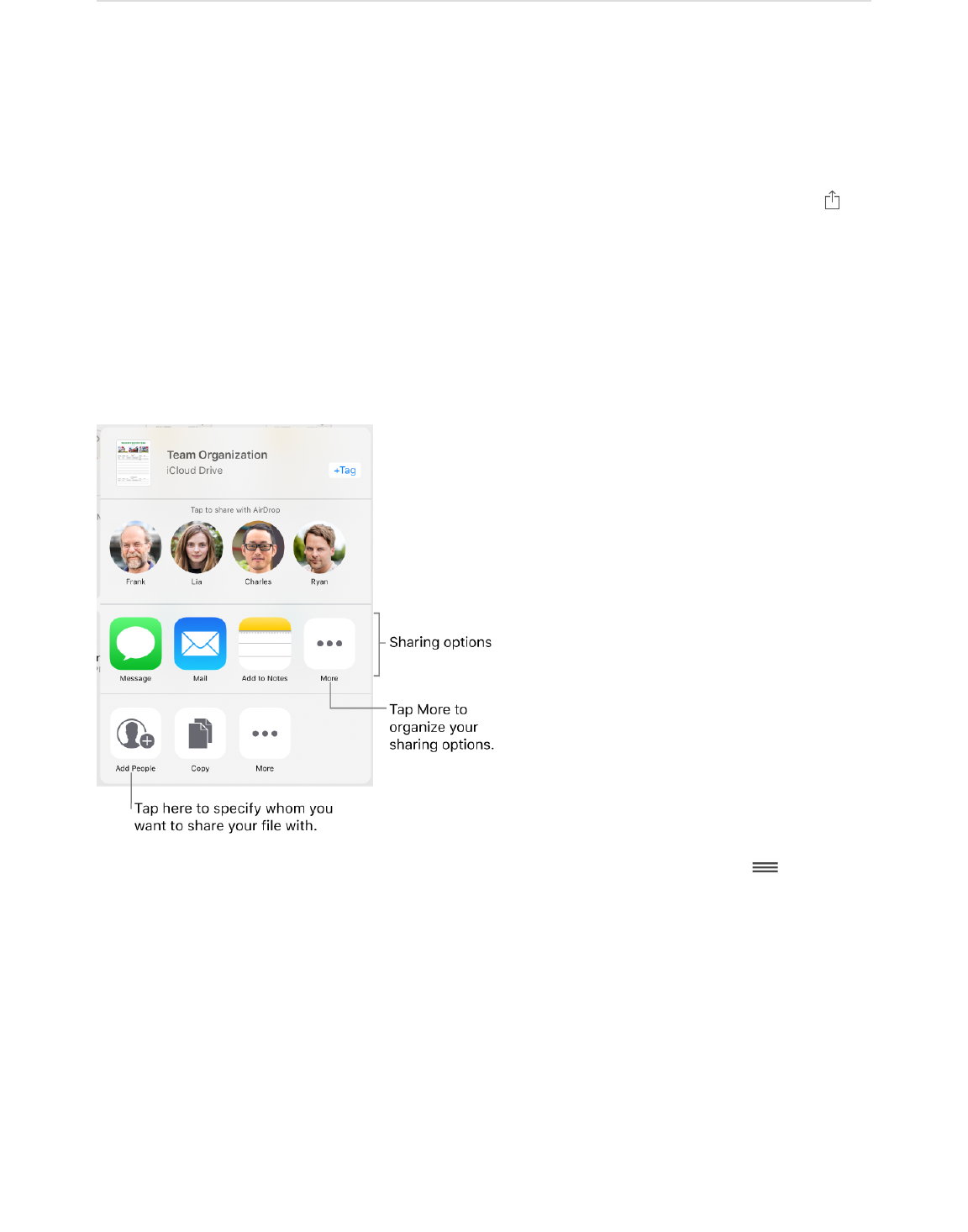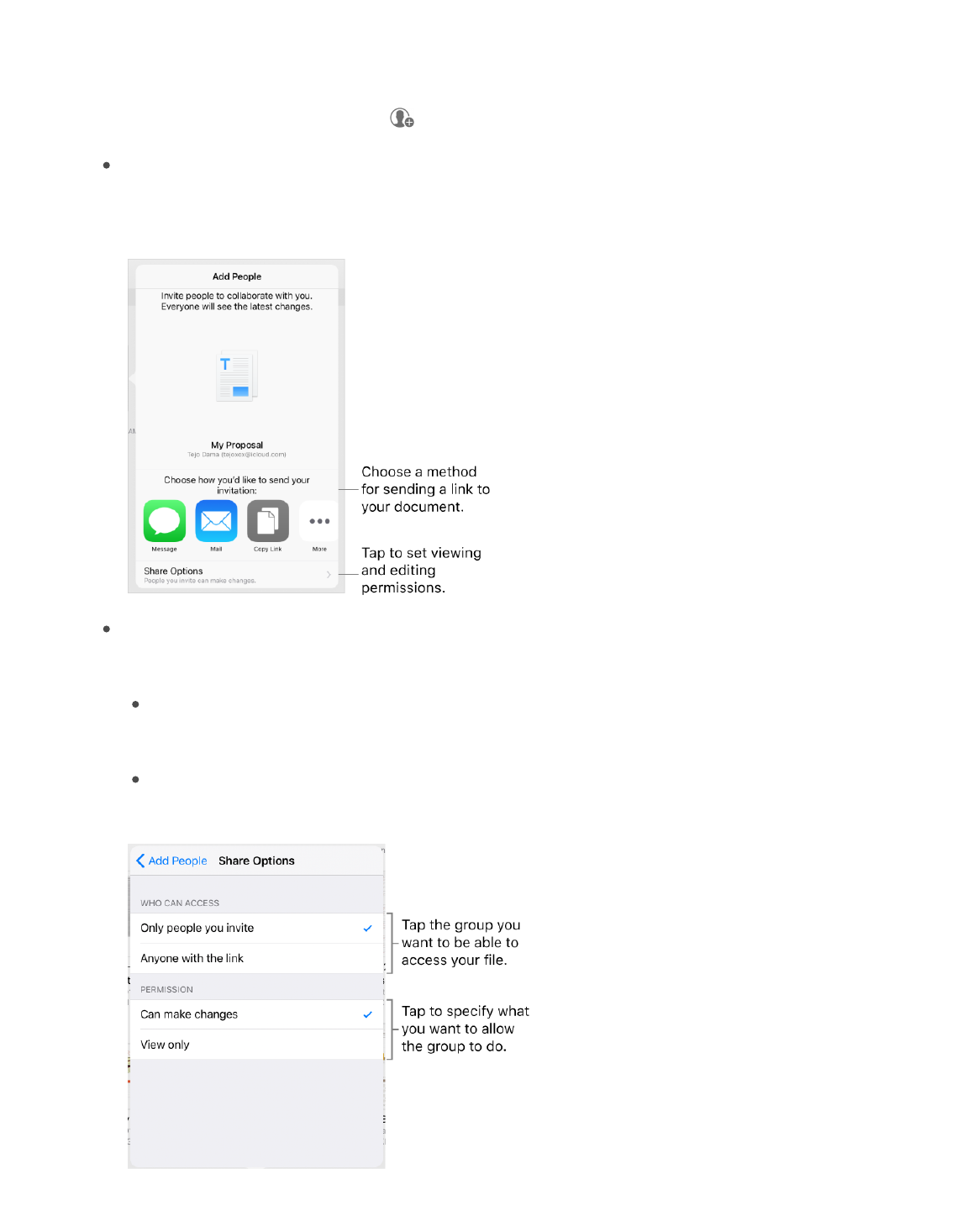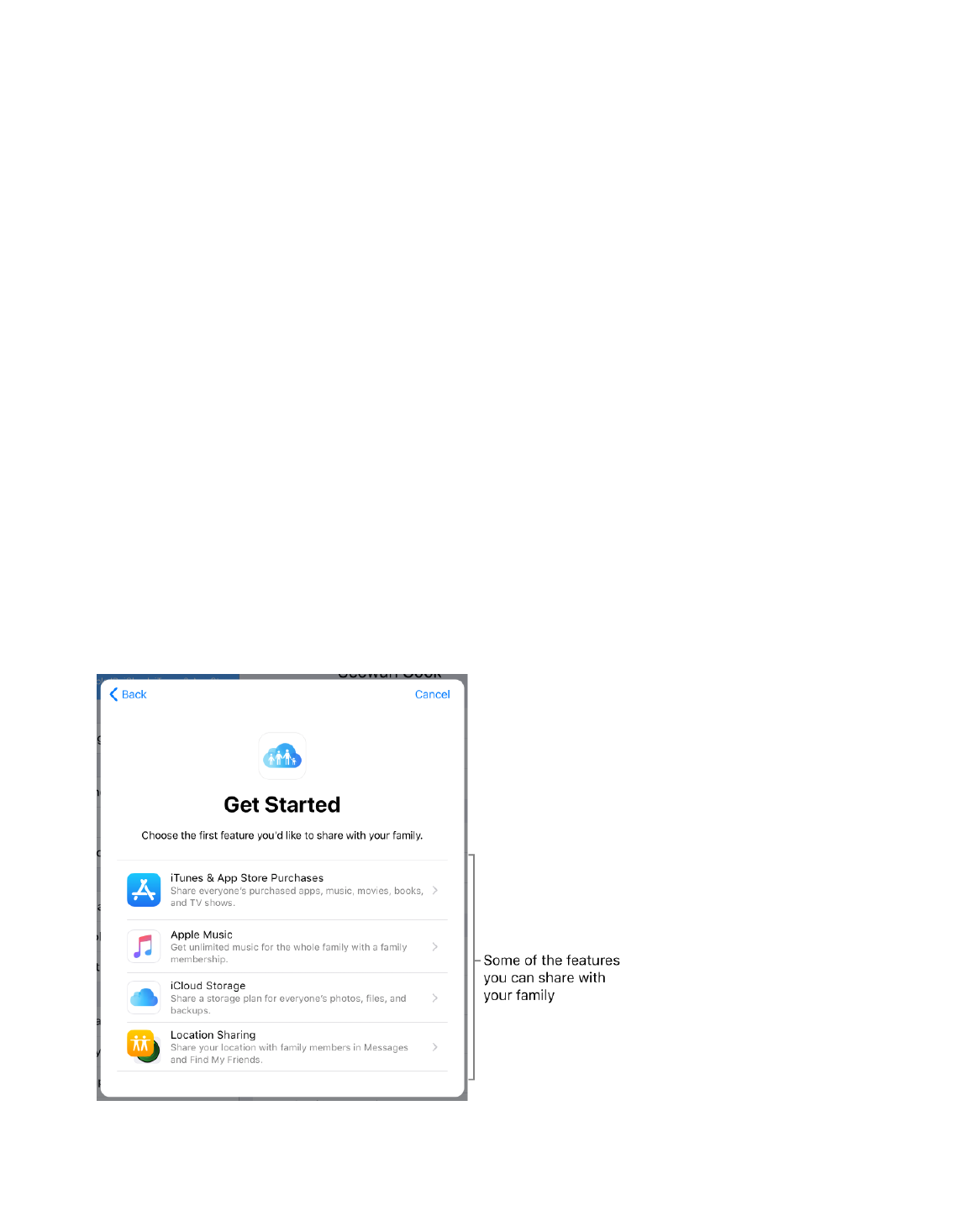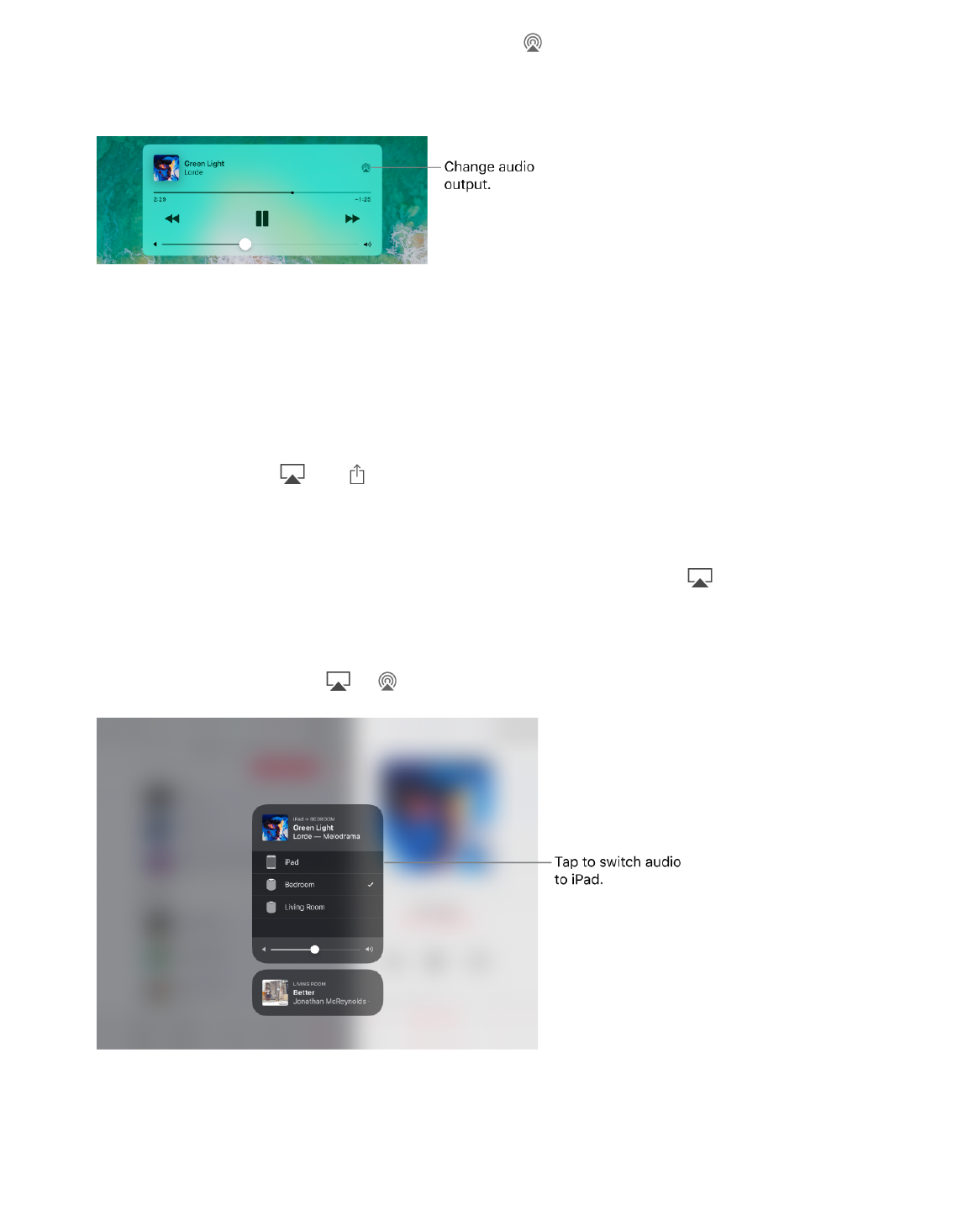Apple A1954 Tablet Device User Manual iPad User Guide
Apple Inc. Tablet Device iPad User Guide
Apple >
Contents
Users Manual 9

Manage photos
The photos you take with Photo Booth are saved to the Camera Roll album or, if you use
iCloud Photo Library, in the All Photos album in the Photos app on iPad.
Delete a photo. Select a thumbnail, then tap .
Share or copy a photo. Tap a thumbnail, tap , then tap a share option or choose Copy.
View photos in the Photos app. In the Photos app, tap Photos. Or tap Albums, tap All
Photos (or Camera Roll if iCloud Photo Library is turned off), then tap a thumbnail. Swipe
left or right to see the next or previous photo. See .
Share photos on all your devices. If you use iCloud Photo Library, you can share your
photos with other devices (iOS 8.1 or later), Mac computers (OS X 10.10.3 or later), and
on . You must be signed in using the same Apple ID. See .
Upload photos to your computer. Connect iPad to your computer using the included
USB cable.
Mac: Select the photos to upload, then click the Import or Download button in Photos
or other supported photo app on your computer.
PC: Follow the instructions that came with your photo app.
If you delete the photos from iPad when you upload them to your computer, theyʼre
removed from Photos. You can use the Photos settings pane in iTunes to sync photos to
the Photos app on iPad.
View photos and videos
iCloud.com iCloud Photo Library

Buy with Apple Pay
On supported models, use Apple Pay (not available in all regions) to make secure
payments in apps and on websites that support Apple Pay. You can also send and receive
money in Messages. Using Apple Pay can be simpler than using a physical card, and
safer too.
Not all Apple Pay features are available in all regions. For information, go to the
.
Set up Apple Pay. Go to Settings > Wallet & Apple Pay, then tap Add Credit or Debit
Card. You may be asked to sign in to iCloud with your Apple ID.
Add a new card: Position iPad so that your card appears in the frame, or enter the
card details manually.
Add your previous cards: Select the card associated with your Apple ID, cards you
use with Apple Pay on your other devices, or cards that youʼve removed. Tap
Continue, then enter the CVV number of each card.
The card issuer determines whether your card is eligible for Apple Pay, and may ask you
for additional information to complete the verification process.
Pay in an app or on the web. During checkout, tap the Apple Pay or Buy with Apple Pay
button. To complete the payment, use Touch ID or your passcode.
You may receive a notification with the merchant name and the amount authorized for the
purchase. Your zip or postal code may be provided to the merchant to calculate tax and
shipping costs. Payment information—such as billing and shipping addresses, email
Apple Pay
Apple Pay
website

address, and phone number—may also be provided to the merchant after you authorize
the payment with Touch ID or a passcode.
Send and receive money (U.S. only)
Use Apple Pay to send and receive money quickly and easily in Messages. Thereʼs no app
to download, and you can use the cards you already have with Apple Pay.
When you receive money in Messages, itʼs added to your Apple Pay Cash card. You can
use Apple Pay Cash right away to make purchases using Apple Pay in stores, in apps, and
on the web. You can also transfer your Apple Pay Cash balance to your bank account.
See .
Before you use Apple Pay Cash or send or receive payments with Apple Pay, you need to
agree to the terms and conditions of these services.
Send a payment. In an iMessage conversation, tap , then tap . Enter the amount,
tap Pay, then add a comment if you want.
Tip: If thereʼs an underlined monetary amount in a message, tap it to preset the
payment.
To complete the payment, tap , then authenticate with Touch ID or enter your
passcode.
Ask Siri. Say something like, “Apple Pay 75 dollars to Aga Orlova for the zipline tour ”
or “Send 75 dollars to Aga Orlova.”
The payment is made with Apple Pay Cash if your balance has sufficient funds.
Otherwise, you can choose a credit, debit, or eligible prepaid card. Credit card payments
incur a 3 percent transaction fee.
Set up and manage Apple Pay Cash (U.S. only)

Cancel a payment. If you sent a payment that hasnʼt been accepted, tap the payment
bubble, then tap Cancel Payment.
Request a payment. Tap , enter the amount, then tap Request.
Ask Siri. Say something like, “Ask mom for 12 dollars for lunch yesterday.”
Manually accept or reject payments. By default, payments are automatically accepted
and added to Apple Pay Cash. To manually accept payments instead, go to Settings >
Wallet & Apple Pay, tap the Apple Pay Cash card, tap , then select Manually Accept
Payments.
Accept a payment: Tap Accept in the payment bubble. You have 7 days to accept a
payment before itʼs returned to the sender.
Reject a payment: Tap the payment bubble, then tap Reject Payment.
View your payment history.
Single payment details: Tap the payment bubble.
All payments: Go to Settings > Wallet & Apple Pay, tap the Apple Pay Cash card, tap
, then tap Transactions. To get a PDF statement of your transaction history by
email, scroll to the bottom, then tap Request Transaction Statement.
Set up and manage Apple Pay Cash (U.S. only)
When you receive money in Messages, itʼs added to your Apple Pay Cash card. You can
use Apple Pay Cash right away to make purchases using Apple Pay in stores, in apps, and
on the web. You can also transfer your Apple Pay Cash balance to your bank account.
Set up Apple Pay Cash. Go to Settings > Wallet & Apple Pay, then turn on Apple Pay
Cash. Or just send or accept a payment in Messages.

Use Apple Pay Cash.
Manage your Apple Pay Cash. Go to Settings > Wallet & Apple Pay, then tap the
Apple Pay Cash card. You can:
Add money from a debit card.
Transfer money from your Apple Pay Cash balance to your bank account.
Tap Transactions to view your history and details (including comments sent with
payments), manually accept or reject individual payments, and request a statement.
Choose to manually or automatically accept all payments.
See your suggested PIN. Apple Pay Cash doesn't require a PIN because every
payment is authenticated by Touch ID or a secure passcode. However, some
terminals may still require you to enter a four-digit code to complete the transaction.
Verify your identity for account servicing and to increase your transaction limits.
Contact Apple Support.
Apple Pay Cash and sending and receiving payments through Apple Pay are services provided by Green Dot
Bank, member FDIC.
View card activity and manage cards
View and manage card information. Go to Settings > Wallet & Apple Pay, then tap a
card. You can:
Tap Transactions to view your recent history. To hide this information, turn off
Transaction History. To view all your Apple Pay activity, see the statement from your
card issuer.
View the last four digits of the card number and Device Account Number—the
number transmitted to the merchant.
Change the billing address.
Remove the card from Apple Pay.
Manage Apple Pay settings. Go to Settings > Wallet & Apple Pay to:
Set your default card.
Send and receive money (U.S. only)
Buy with Apple Pay

Add the shipping address and contact information for purchases.
If your iPad is lost or stolen. If you enabled , you can use it to help locate
and secure your iPad. You can also suspend or remove the ability to make purchases
using your cards in Apple Pay:
On a Mac or PC: Sign in to using your Apple ID, click Settings, click the
lost iPad in the My Devices section, then click Remove in the Apple Pay section.
On another iOS device: Go to Settings > [your name], tap the lost iPad, then tap
Remove All Cards (below Apple Pay).
You can also call the issuers of your cards.
Note: If you sign out of iCloud in Settings > [your name], all your credit and debit cards
for Apple Pay are removed from iPad. You can add the cards again the next time you sign
in to iCloud.
Find My iPad
iCloud.com

Share from apps
Share from an app (except Files). In many apps that support sharing, tap Share or ,
then choose how to share. Options vary by app and may include choices from apps
youʼve downloaded. For example, if you download Pinterest, Pinterest may appear as
another option for sharing. For more information, see .
Share from the Files app. You can send a copy of any document in . Touch and hold
the document, tap Share, then choose an option for sending the document (for example,
Message, Mail, and so on).
Organize your sharing options. Tap the More button, then touch and drag to move
items to new positions.
Share files from iCloud Drive
With iCloud Drive, you can store files in iCloud and access them from all your devices.
Any changes you make appear on all your devices set up with iCloud Drive.
You can also invite others to view and edit your files in iCloud Drive. They can access
your shared file by tapping a link you send—you donʼt need to send the file.
To use iCloud Drive, you must be signed in to iCloud using your Apple ID, and have
iCloud Drive turned on.
Sharing
App extensions
Files

Turn on iCloud Drive. Go to Settings > [your name] > iCloud, then turn on iCloud Drive).
See .
Invite others to view or edit a file. Tap Files > Browse > iCloud Drive. Touch and hold a
file in iCloud Drive, tap Share, tap , then do one of the following:
Send a link to the people you want to view and edit the file: Tap a method for sending
a link to the file, enter any other requested information, then send or post the
invitation. People need an Apple ID to open the file.
Choose specific permission and access options: Tap Share Options, then select
permission settings:
Who can open, view, and print the file, but not make changes—only people you
invite or anyone with the link.
Who can open, view, print, and make changes to the file—only people you invite or
anyone with the link.
When you allow people to edit a file, itʼs updated with everyoneʼs changes automatically.
Use iCloud Drive

Note: If you donʼt see , the file may be owned by someone else who shared it with you.
Tap Show People to see the owner ʼs name.
After you set the share options, tap Add People at the top left. Tap a method for sending
a link to the document (Message, Mail, and so on), enter any other requested information,
then send or post the invitation. See .
Important: When you share a file that you have in iCloud Drive, a link to it (including its
name) is sent in your invitation. If the document is confidential, be sure to ask recipients
not to forward the link to anyone else.
Share files with AirDrop
With AirDrop you can share your photos, videos, websites, locations, and more wirelessly
with other nearby devices (iOS 7 or later). With iOS 8 or later, you can share with Mac
computers with OS X 10.10 or later. AirDrop transfers information using Wi-Fi and
Bluetooth—both must be turned on. To use AirDrop, you need to be signed in to iCloud
using your Apple ID. Transfers are encrypted for security.
Share an item using AirDrop. Tap Share , then tap the name of a nearby AirDrop user.
Receive AirDrop items from others. Open Control Center, then tap (if you donʼt see
, tap and hold the top left group of controls). Then choose to receive items from
Contacts only or from Everyone. You can accept or decline each request as it arrives.
For more information, see the Apple Support article
.
Use iCloud Drive
How to use AirDrop with your iPhone,
iPad, or iPod touch

Family Sharing
With Family Sharing, up to six family members can share iTunes Store, App Store, and
iBooks Store purchases; an Apple Music family membership; an iCloud storage plan; a
family calendar; family photos; and more, all without sharing accounts. For more
information, see the Apple Support article .
To use Family Sharing, one adult family member (the organizer) chooses features for the
family to share and invites up to five additional family members to participate. When
family members join, Family Sharing is set up on their devices automatically.
Family Sharing requires you to sign in to iCloud with your Apple ID, and to confirm the
Apple ID you use for the iTunes Store, App Store, and iBooks Store (you usually use the
same Apple ID for everything). Family Sharing is available on iOS devices with iOS 8 or
later, Mac computers with OS X 10.10 or later, and PCs with iCloud for Windows 5 or later.
You can be part of only one family group at a time.
Set up Family Sharing. Go to Settings > [your name] > Set Up Family Sharing, then
follow the onscreen instructions. As the family organizer, you choose the features you
want to share and invite family members to join. Depending on the services you choose,
you may be asked to set up an Apple Music family membership or an iCloud Storage
subscription. If you choose to share iTunes Store, App Store, and iBooks Store purchases
with your family members, you agree to pay for any purchases they initiate while part of
the family group.
Create an Apple ID for a child. Go to Settings > [your name] > Family Sharing, then tap
Create a Child Account. For more information, see the Apple Support article
.
Family Sharing
Family
Sharing and Apple ID for your child

Accept an invitation to Family Sharing. Tap Accept in your invitation. Or, if you are near
the organizer during the setup process, you can enter the Apple ID and password you use
for iCloud on the organizerʼs device.
Share purchases. When your family uses iTunes Store, App Store, and iBooks Store
purchase sharing, all items are billed directly to the family organizerʼs Apple ID. Once
purchased, an item is added to the initiating family memberʼs account and is shared with
the rest of the family.
Access shared purchases from the iTunes Store. Open the iTunes Store, tap
Purchased, then tap My Purchases at the top left. Choose a family member, tap a
category (for example, Music or Movies) at the top of the screen, then tap a purchased
item.
Access shared purchases from the App Store. Open the App Store, then tap the photo
or at the top right. Tap Purchased, choose a family member, then tap a purchased
item.
Access shared purchases from the iBooks Store. Open iBooks, tap Reading Now, then
tap the photo or at the top right. Choose a family member, tap a category (for
example, Books or Audiobooks), tap a genre, then tap a purchased item.
Use a shared Apple Music family membership. If your family has an Apple Music family
membership, you can simply open Apple Music and start listening. Each family member
gets their own music library and personal recommendations. Make sure youʼre signed in
with the Apple ID you entered in Family Sharing settings.
Use a shared iCloud storage plan. If your family is sharing an iCloud storage plan
(200 GB or 2 TB), you can privately use as much storage as you need. You can also
purchase or use your own storage plan if you need more space.
Turn on Ask to Buy. The family organizer can require young family members to request
approval for purchases or free downloads. Go to Settings > [your name] > Family Sharing,
then tap the personʼs name.
Note: Age restrictions for Ask to Buy vary by region. In the United States, the family
organizer can enable Ask to Buy for any family member under age 18; for children under
age 13, itʼs enabled by default.
Hide your iTunes Store, App Store, and iBooks Store purchases. To hide all your
purchases from family members, go to Settings > [your name] > Family Sharing, then
turn off Share My Purchases. On your computer, you can also hide specific purchases so
they arenʼt available to other family members. For more information, see the Apple
Support article .
Hide and unhide apps for your iPhone, iPad, iPod touch, or Mac

Share photos or videos with family members. When you set up Family Sharing, a
shared album called Family is automatically created in the Photos app on all family
membersʼ devices. To share a photo or video with family members, open the Photos app,
then view a photo or video or select multiple photos or videos. Tap , tap iCloud Photo
Sharing, add comments, then share to your shared family album. Members can
unsubscribe from the family album, and the family organizer can delete it. See
.
Add an event to the family calendar. When you set up Family Sharing, a shared
calendar called Family is automatically created in the Calendar app on all family
membersʼ devices. To add a family event, open the Calendar app, create an event, then
add the event to the family calendar. Members can unsubscribe from the family calendar,
and the family organizer can delete it. See .
Set up a family reminder. When you set up Family Sharing, a shared list is automatically
created in the Reminders app on all family membersʼ devices. To add a reminder to the
family list, open the Reminders app, tap the family list, then add a reminder to the list.
Members can unsubscribe from the family reminder list, and the family organizer can
delete it. See .
Share your location with family members. Go to Settings > [your name] > iCloud >
Share My Location. To find a family memberʼs location, use the Find My Friends app. You
can also send or share your location with the Messages app (iOS 8 or later required). For
more information about using Messages to share your location, see
.
Keep track of your familyʼs devices. If family members enabled Share My Location in
iCloud, you can help them locate missing devices. Open Find iPhone on your device or at
iCloud.com. For more information, see .
Leave Family Sharing. Go to Settings > [your name] > Family Sharing > [your name],
then tap Leave Family Sharing. If youʼre the organizer, tap Stop Family Sharing. For more
information, see the Apple Support article .
iCloud
Photo Sharing
Share iCloud calendars
Reminder lists
Send and receive
messages
Find your iPad
Leave Family Sharing

Connect Bluetooth devices
You can use Bluetooth devices such as wireless headphones, speakers, and more with
iPad. For information, see the Apple Support article .
WARNING: For important information about avoiding hearing loss and avoiding
distractions that could lead to dangerous situations, see .
Note: The use of certain accessories with iPad may affect wireless performance. Not all
iOS accessories are fully compatible with iPad. Turning on airplane mode may eliminate
audio interference between iPad and an accessory. Reorienting or relocating iPad and the
connected accessory may improve wireless performance.
Turn Bluetooth on or off. Go to Settings > Bluetooth. To quickly disconnect from
Bluetooth devices without turning Bluetooth off, open Control Center, then tap .
Pair a Bluetooth device. Follow the instructions that came with the device to put it in
discovery mode. Then go to Settings > Bluetooth, and tap the device in the Devices list to
connect.
iPad must be within about 33 feet (10 meters) of the Bluetooth device.
If you have AirPods and you set them up with one iOS device or Mac computer, they are
automatically set up with your other devices where youʼre signed in using the same
iCloud account (iOS 10, macOS Sierra, watchOS 3, or later required). For more
information about setting up AirPods, go to the .
For information about Apple Wireless Keyboard, see .
Unpair a device. Go to Settings > Bluetooth, tap next to the device, then tap Forget
This Device. If you donʼt see the Devices list, make sure Bluetooth is on.
If you have AirPods and you tap Forget This Device, they are automatically removed from
other devices that are set up through your iCloud account.
Stream audio and video to other devices
Stream content from iPad to AirPlay-enabled or Bluetooth devices, or mirror your iPad
screen. (Apple TV, AirPlay-enabled devices, and Bluetooth devices are available
separately.)
iPad and other devices
Supported Bluetooth profiles
Important safety information
AirPods Support website
Use an Apple Wireless Keyboard

Stream audio to an Apple TV, an AirPlay-enabled device, or a connected Bluetooth
device. Open the audio app you want to use, tap , then choose a playback destination,
such as HomePod, Apple TV, or wireless headphones. While audio is playing, you can
also change the playback destination from the Lock screen or Control Center.
Note: If your AirPlay-enabled devices donʼt appear as a destination, make sure everything
is on the same Wi-Fi network.
With a Bluetooth device, the playback destination returns to iPad if the device moves out
of range.
Stream photos and video to an Apple TV using AirPlay. Open the photo or video app
you want to use. Tap , tap , then tap AirPlay. Then choose your Apple TV as the
playback destination. If an AirPlay passcode appears on the TV screen, enter the
passcode on your iPad.
Mirror your iPad screen on an Apple TV. Open Control Center, tap , then choose
your Apple TV as the playback destination. If an AirPlay passcode appears on the TV
screen, enter the passcode on your iPad.
Switch back to iPad. Tap or , then choose your iPad.
You can also connect iPad to a TV, projector, or other external display using the
appropriate Apple cable or adapter. For more information, see the Apple Support article
.
About Apple Digital AV Adapters for iPhone, iPad, and iPod touch

Control audio on multiple devices
With AirPlay and iPad, you can play different audio streams on AirPlay-compatible
devices connected to the same Wi-Fi network. For example, while playing your Chill Mix
on iPad, you can also play a podcast on the kitchen HomePod, and a favorite jazz playlist
on the living room Apple TV.
Choose a device in the Music or Podcasts app. On iPad, open the Music or Podcasts
app. Tap Now Playing at the bottom of the screen, then tap to see separate cards for
iPad and each Apple TV, HomePod, or other AirPlay-compatible device.
Tap the card for the device you want to control, then choose some music or a podcast to
play. Tap a different card and choose some audio to play on that device.
Choose a device from Control Center. Open Control Center, then touch and hold the
audio card. Tap , then tap the card for the device you want to control.
Apple Pencil
With iPad Pro or iPad (6th generation), you can use Apple Pencil (available separately) to:
Write a note by hand
Create a detailed sketch
Sign a document
Markup a PDF file, photo, email, and more

For more information, see the Apple Support article .
AirPrint
Use AirPrint to print wirelessly to an AirPrint-enabled printer from apps such as Mail,
Photos, and Safari. Many apps available on the App Store also support AirPrint.
iPad and the printer must be on the same Wi-Fi network. For more information about
AirPrint, see the Apple Support article .
Print a document. Tap or (depending on the app youʼre using).
See the status of a print job. Open the App Switcher, then tap Print Center. The badge
on the icon shows how many documents are in the queue.
Cancel a job. Select it in Print Center, then tap Cancel Printing.
Handoff
Continue working on one device where you left off on another. You can use Handoff with
many Apple apps—for example, Mail, Safari, Pages, Numbers, Keynote, Maps, Messages,
Reminders, Calendar, and Contacts—and even some third-party apps. To use Handoff,
you must be signed in to iCloud using the same Apple ID on all your devices. Your devices
must have Bluetooth on and be within Bluetooth range of one another (about 33 feet or
10 meters).
Switch devices.
From Mac to iPad: The Handoff icon of the app youʼre using on your Mac appears on
iPad on the right side of the Dock. Tap the Handoff icon to continue working in the
app on iPad.
From iPad to Mac: The Handoff icon of the app youʼre using on iPad appears on your
Mac at the left end of the Dock (or the top, depending on the Dock position). Click
the icon to continue working in the app.
Disable Handoff on your devices.
iOS devices: Go to Settings > General > Handoff.
Mac: Choose Apple Menu > System Preferences > General, then turn off “Allow
Handoff between this Mac and your iCloud devices.”
Use Apple Pencil with iPad Pro
About AirPrint

Universal Clipboard
Cut or copy content (a block of text or an image, for example) on your iPad, then paste it
on another iOS device or Mac computer, and vice versa.
For Universal Clipboard to work, you must be signed in to iCloud using the same Apple ID
on all your devices. Your devices must be connected to Wi-Fi, be within Bluetooth range
of one another (about 33 feet or 10 meters), have Bluetooth on, and have
. Universal Clipboard requires iOS 10 and macOS Sierra.
You must cut, copy, and paste your content within a short period of time.
Copy or cut. Touch and hold a word or image to display the selection options, then
choose Copy or Cut.
Paste. Double-tap to place an insertion point and display the selection options, then
choose Paste.
For more information about selecting text or placing the insertion point, see
.
Make and receive Wi-Fi calls on iPad
Wi-Fi calling lets you make and receive calls on your iPad, iPod touch, or Mac by relaying
calls through your iPhone. To make calls this way, you need iOS 9 or later and OS X 10.10
or later. You must be signed in to iCloud and FaceTime on all your devices using the same
Apple ID as on iPhone.
Note: Wi-Fi calling on other devices is available with some carriers, and cellular charges
may apply.
You must first set up your iPhone, then your other devices. If you log out of iCloud or
FaceTime on iPhone, Wi-Fi calling is disabled.
Turn on Wi-Fi calls on your iPhone. Go to Settings > Phone > Wi-Fi Calling, then turn on
Wi-Fi Calling on This iPhone. Go to Settings > Phone > Call on Other Devices, turn on
Allow Calls on Other Devices, then select your iPad.
Turn on Wi-Fi Calling on your iPad. Go to Settings > FaceTime, turn on FaceTime, then
turn on Calls from iPhone.
Note: If you enable Wi-Fi Calling, emergency calls may be made over Wi-Fi, and your
deviceʼs location information may be used for emergency calls to aid response efforts,
regardless of whether you enable Location Services. Some carriers may use the address
you registered with the carrier when signing up for Wi-Fi Calling as your location.
Handoff
enabled
Type and
edit text

Make a phone call on your iPad. Tap a phone number in Contacts, Calendar, FaceTime,
Messages, or Safari.
Receive a call on your iPad. Swipe the notification to answer, ignore, or respond with a
quick message.
For more information about Wi-Fi calls, see the Apple Support article
.
Instant Hotspot
You can use Instant Hotspot on your iPhone (with iOS 8 or later) or iPad (Wi-Fi + Cellular
models with iOS 8 or later) to provide Internet access to your other devices (iOS 8 or
later) and Mac computers (OS X 10.10 or later) where youʼre signed in to iCloud with the
same Apple ID. Instant Hotspot uses your iPhone or iPad Personal Hotspot, without you
having to enter a password or even turn on Personal Hotspot.
Use Instant Hotspot. Go to Settings > Wi-Fi on your iOS (models without cellular
capabilities). Below Personal Hotspots, choose your iPhone or iPad network. On your
Mac, choose your iPhone or iPad network from your Wi-Fi settings.
When youʼre not using the hotspot, your devices disconnect to save battery life. For more
information about ways to set up a Personal Hotspot see .
Note: This feature may not be available with all carriers. Additional fees may apply.
Contact your carrier for more information.
Personal Hotspot
Use Personal Hotspot to share your iPad (Wi-Fi + Cellular models) Internet connection.
Computers can share your Internet connection using Wi-Fi, Bluetooth, or a USB cable.
Other iOS devices can share the connection using Wi-Fi. Personal Hotspot works only if
iPad is connected to the Internet over the cellular data network.
Note: This feature may not be available with all carriers. Additional fees may apply.
Contact your carrier for more information.
Share an Internet connection. Go to Settings > Cellular Data, then tap Personal Hotspot
—if it appears—to set up the service with your carrier.
After you turn on Personal Hotspot, other devices can connect in the following ways:
Wi-Fi: On the device, choose your iPad from the list of available Wi-Fi networks.
Make a call with Wi-
Fi Calling
Personal Hotspot

USB: Connect iPad to your computer using the cable that came with it. In your
computerʼs Network preferences, choose iPad, then configure the network settings.
Bluetooth: On iPad, go to Settings > Bluetooth, then turn on Bluetooth. To pair and
connect iPad with your Bluetooth device, refer to the documentation that came with
your device.
Note: When a device is connected, a blue band appears at the top of the iPad screen.
The Personal Hotspot icon appears in the status bar of iOS devices using Personal
Hotspot.
Change the Wi-Fi password for iPad. Go to Settings > Personal Hotspot > Wi-Fi
Password, then enter a password of at least eight characters.
Change the name of your Personal Hotspot. You can change the name of your
Personal Hotspot by changing the name of your iPad. Go to Settings > General > About >
Name.
Monitor your cellular data network usage. Go to Settings > Cellular. See
.
Use iTunes to transfer files
You can transfer files between iPad and your computer or other iOS devices with ,
, , or by connecting iPad to your computer and using iTunes.
Transfer files using iTunes. Connect iPad to your computer using the included cable. In
iTunes on your computer, select iPad, then click Apps. Use the File Sharing section to
transfer documents between iPad and your computer.
Apps that support file sharing appear in the Apps list. To delete a file, select it in the
Documents list on your computer, then press the Delete key. For more information, see
the Apple Support article .
Cellular data
settings
Files
AirDrop email attachments
About File Sharing on iPhone, iPad, and iPod touch

Privacy
Location Services
Location Services lets location-based apps such as Reminders, Maps, and Camera gather
and use data indicating your location. Your approximate location is determined using
available information from local Wi-Fi networks, if you have Wi-Fi turned on. The location
data collected by Apple isnʼt collected in a form that personally identifies you. When an
app is using Location Services, appears in the status bar.
Privacy settings let you see and control which apps and system services have access to
Location Services, and to Contacts, Calendars, Reminders, and Photos.
Turn Location Services on or off. Go to Settings > Privacy > Location Services. You can
turn it off for some or for all apps and services. If you turn off Location Services, youʼre
asked to turn it on again the next time an app or service tries to use it.
Turn Location Services off for system services. Several system services, such as
location-based ads, use Location Services. To see their status, turn them on or off, or
show in the status bar when these services use your location, go to Settings >
Privacy > Location Services > System Services.
Turn off access to private information. Go to Settings > Privacy. You can see which
apps and features have requested, and you have granted, access to private information.
You can turn off each appʼs access to each of these categories of information:
Contacts
Calendar
Reminders
Photos
Bluetooth Sharing
Microphone
Speech Recognition
Camera
Privacy and security

HomeKit
Media & Apple Music
Motion & Fitness
Review the terms and privacy policy for each third-party app to understand how it uses
the data itʼs requesting. For more information, see the Apple Support article
.
Advertising and tracking
Turn off location-based ads and offers. Go to Settings > Privacy > Location Services >
System Services, then turn off Location-Based Apple Ads.
Reset or limit Ad Tracking. Go to Settings > Privacy > Advertising (at the bottom of the
screen). To clear the data used to determine which ads might be relevant to you, tap
Reset Advertising Identifier. To opt out of targeted advertising, turn on Limit Ad Tracking.
Note: If you turn on Limit Ad Tracking, you may still receive the same number of ads, but
they may be less relevant to you.
View the information Apple uses to deliver targeted ads. Go to Settings > Privacy >
Advertising > View Ad information. The information is used by Apple to deliver more
relevant ads in Apple News and the App Store. Your personal data is not provided to
other parties.
Keep your Safari browsing activities to yourself. While browsing the web, you can
prevent cross-site tracking, block cookies, erase your browsing history, and more. See
for Safari.
For more information, go to Settings > Privacy > Advertising > About Advertising &
Privacy.
About
privacy and Location Services
Privacy and security

Security
Passcode
For better security, you can set a passcode that must be entered each time you turn on
or wake up iPad.
Set, change, or turn off the passcode. Go to Settings > Touch ID & Passcode
(supported models) or Settings > Passcode (other models).
To adjust when iPad automatically locks (and then requires the passcode to unlock), go
to Settings > Display & Brightness > Auto-Lock.
Setting a passcode turns on data protection, using your passcode as a key to encrypt
Mail messages and attachments stored on iPad, using 256-bit AES encryption. (Other
apps may also use data protection.)
Increase security. Turn off Simple Passcode and use a longer passcode. To enter a
passcode thatʼs a combination of numbers and letters, you use the keyboard. If you
prefer to unlock iPad using the numeric keypad, set up a longer passcode using numbers
only.
Add fingerprints and set options for Touch ID. (Supported models) Go to Settings >
Touch ID & Passcode. See .
Allow access to features when iPad is locked. Go to Settings > Touch ID & Passcode
(supported models) or Settings > Passcode (other models). Optional features include:
Today View (see )
Recent Notifications (see )
Control Center (see )
Siri (see )
Home Control (see )
Return Missed Calls (see )
Erase data after ten failed passcode attempts. Go to Settings > Touch ID & Passcode
(supported models) or Settings > Passcode (other models), then tap Erase Data. After
ten failed attempts to enter your passcode, all settings are reset, all your information and
media are erased, and you must or .
Touch ID
Today View
Notifications
Control Center
Make requests
Home overview
Make and answer calls
restore iPad from a backup set it up again as new

Two-factor authentication
Two-factor authentication is an extra layer of security for your Apple ID designed to
ensure that youʼre the only person who can access your account, even if someone knows
your password. Itʼs built into iOS 9 and later, and OS X 10.11 and later.
Turn on two-factor authentication. Turn it on when asked while setting up iPad. Or, go
to Settings > [your name] > Password & Security, then tap Turn On Two-Factor
Authentication.
When asked, verify your identity with a six-digit verification code (as described below).
You wonʼt be asked for a verification code again on your iPad unless you sign out
completely, erase your iPad, sign in to your in Safari on your iPad,
or need to change your Apple ID password for security reasons.
Note: If you use two-step verification and upgrade to iOS 11 or later, your account might
be migrated to use two-factor authentication. Your account will have an optional,
additional recovery factor: a recovery key that can be generated on iPad. For more
information, see the Apple Support article
.
Verify your identity with a six-digit verification code. When youʼre asked on your iPad
for the code, look for a notification on any of your trusted devices or at a trusted phone
number. On a trusted device, tap or click Allow to make a code appear on that device. To
send the code to a trusted phone number, tap “Didnʼt get a verification code?”, then
choose the phone number. Enter the code on your iPad.
If you canʼt receive a verification code automatically on your trusted devices (described
below), and a trusted phone number (described below) is unavailable, you can get a
verification code from Settings on a trusted device, even if your device is offline. On a
trusted iOS device, go to Settings > [your name] > Password & Security, then tap Get
Verification Code. On a trusted Mac, choose Apple Menu > System Preferences >
iCloud > Account Details > Security, then click Get Verification Code.
Add another iOS device (iOS 9 or later) or a Mac (OS X El Capitan or later) as a
trusted device. After you turn on two-factor authentication, use the same Apple ID to
sign in to iCloud on another device. If you previously signed in, sign in again. (On an iOS
device, go to Settings > [your name]. On a Mac, choose Apple Menu > System
Preferences > iCloud.) Verify your identity with a six-digit verification code (as described
above). You can receive verification codes on all your trusted devices.
You wonʼt be asked for a verification code again on a trusted device unless you sign out
completely, erase your device, sign in to your Apple ID account page in Safari on that
device, or need to change your Apple ID password for security reasons.
Apple ID account page
Switch from two-step verification to two-factor
authentication

Add a trusted phone number. Go to Settings > [your name] > Password & Security, tap
Edit (above the list of trusted phone numbers), then tap Add a Trusted Phone Number.
You must verify at least one trusted phone number to enroll in two-factor authentication.
You should also consider verifying other phone numbers you can access, such as a home
phone, or a number used by a family member or close friend. Trusted phone numbers
donʼt automatically receive verification codes. If you canʼt access any trusted devices
when setting up a new device for two-factor authentication, tap “Didnʼt get a verification
code?” on the new device, then choose one of your trusted phone numbers to receive
the verification code.
Remove a trusted phone number. Go to Settings > [your name] > Password & Security,
tap Edit (above the list of trusted phone numbers), then tap next to the phone number.
Get a verification code on a trusted iPad, even when youʼre offline. If you need to
enter a verification code on another device when setting it up for two-factor
authentication, but you canʼt receive the code on a trusted iPad automatically, you can
get a verification code from Settings on the trusted iPad. Go to Settings > [your name] >
Password & Security, then tap Get Verification Code.
View or remove trusted devices. Go to Settings > [your name]. A list of the devices
associated with your Apple ID appears near the bottom of the screen. To see if a listed
device is trusted, tap it, then look for “This device is trusted and can receive Apple ID
verification codes.” To remove a device, tap it, then tap Remove From Account.
Turn off two-factor authentication. Sign in to your , tap Security,
tap Edit, then tap Turn Off Two-Factor Authentication.
For more help with two-factor authentication, see the Apple Support article
.
Touch ID
(Supported models) When you set up Touch ID, you can unlock iPad by placing a finger
on the Home button. You can use Touch ID to authorize purchases from the iTunes Store,
App Store, and iBooks Store, and to authorize payments with Apple Pay. You can also
sign in to many third-party apps using Touch ID.
To use Touch ID, you must on your iPad. You must enter your passcode
for additional security validation when you do the following:
Turn on or restart your device
Update your software
Erase your device
Apple ID account page
Two-factor
authentication for Apple ID
set a passcode

View or change passcode settings
Install iOS configuration profiles
Set up fingerprint recognition. Follow the onscreen instructions when you first
, or go to Settings > Touch ID & Passcode. Set whether you want to use a fingerprint
to unlock iPad and to make purchases. Tap Add a Fingerprint, then follow the onscreen
instructions. You can add multiple fingerprints (both of your thumbs and forefingers, for
example, and one for your spouse).
Name a fingerprint. Tap the fingerprint, then enter a name, such as “Thumb.”
Delete a fingerprint. Tap the fingerprint, then tap Delete Fingerprint. If you added more
than one fingerprint, place a finger on the Home button to find out which fingerprint it is.
Use Touch ID to make a payment in the iTunes Store, App Store, or iBooks Store.
Follow the instructions to enable purchases with your fingerprint. Or go to Settings >
Touch ID & Passcode, then turn on iTunes & App Store.
Note: Youʼre asked for your Apple ID password for the first purchase you make in the
iTunes Store, App Store, or iBooks Store.
Use Touch ID to make a payment within an app or on a website that supports
Apple Pay. Go to Settings > Touch ID & Passcode to ensure that Apple Pay is turned on
for Touch ID. To complete a payment with Apple Pay, approve with Touch ID. For more
information about Apple Pay, go to the .
Turn off Touch ID. Go to Settings > Touch ID & Passcode, then turn off one or more
options: iPad Unlock, Apple Pay, or iTunes & App Store.
iCloud Keychain
iCloud Keychain keeps your Safari website user names and passwords, credit card
information, and Wi-Fi network information up to date across all of your approved devices
(iOS 7 or later) and Mac computers (OS X 10.9 or later). iCloud Keychain is secured with
256-bit AES encryption during storage and transmission, and its data cannot be read by
Apple.
iCloud Keychain works with Safari Password Generator and AutoFill. When youʼre setting
up a new account, Safari Password Generator suggests unique, hard-to-guess
passwords. You can to have iPad enter your user name, password, and credit
card info automatically. To protect your personal information, if you turn
on iCloud Keychain and AutoFill.
Note: Some websites do not support AutoFill.
set up
iPad
Apple Pay website
use AutoFill
set a passcode

iCloud Keychain can also keep the accounts you use in Mail, Contacts, Calendar, and
Messages up to date across all of your iOS devices and Mac computers.
To learn more about iCloud Keychain, see the Apple Support article
.
Set up iCloud Keychain. Go to Settings > [your name] > iCloud > Keychain. Turn on
iCloud Keychain, then follow the onscreen instructions.
When you set up iCloud Keychain, you create an iCloud Security Code. You can use your
iCloud Security Code to authorize additional devices to use your iCloud Keychain. Itʼs also
used to verify your identity so that you can perform other iCloud Keychain actions, such
as recovering your iCloud Keychain if you lose all your devices.
Set up iCloud Keychain on additional devices. Set up iCloud Keychain for each device
that you want to add. When you turn on iCloud Keychain on an additional device, your
other devices that use iCloud Keychain receive a notification requesting approval for the
additional device. After you approve the additional device, your iCloud Keychain
automatically begins updating on that device.
To approve iCloud Keychain on an additional device when you donʼt have access to your
other devices, follow the onscreen instructions to use your iCloud Security Code.
Forgot your iCloud Security Code? If you enter the wrong iCloud Security Code too
many times when using iCloud Keychain, your iCloud Keychain is disabled on that device,
and your keychain in iCloud is deleted. To reset or create a new iCloud Security Code, see
the Apple Support article
.
Find your iPad
If you misplace your iPad, the Find My iPhone app can help you locate it and protect your
data. Use the Find My iPhone app on another iPad, iPhone, or iPod touch—or use the
on any Mac or PC—to locate your iPad on a map, lock it
remotely, play a sound, display a message, or erase all its data. Find My iPhone includes a
feature called Activation Lock that prevents anyone else from activating and using your
iPad, even if itʼs completely erased.
You can also use Find My iPhone to locate your AirPods, your Apple Watch, and your
other iOS devices.
Note: For more information about Find My iPhone, refer to the Help in the app.
Allow Find My iPhone to locate your iPad. Go to Settings > [your name] > iCloud, then
turn on Find My iPad. Also turn on Send Last Location to have iPad send its last location
prior to the battery running out. (See if you need help setting up iCloud.)
Frequently asked
questions
If you enter your iCloud Security Code incorrectly too many
times
Find My iPhone web app
iCloud

Important: To use these features, the Find My iPad setting must be turned on before
your iPad is lost. iPad must be able to connect to the Internet for you to locate and secure
the device.
Use Find My iPhone. On iPad or another iOS device, open the Find My iPhone app. Or on
a computer, go to the . Sign in, then select the device you want
to locate.
Play Sound: Play a sound at full volume for two minutes, even if the ringer is set to
silent.
Lost Mode: Immediately lock your missing iPad with a passcode and display a custom
message on the screen with a contact number. Find My iPhone tracks and reports the
location of your iPad, so you can see where itʼs been.
When iPad is in Lost Mode on models that support Apple Pay, Find My iPhone
attempts to suspend the ability to pay with credit and debit cards used for Apple Pay.
Erase iPad: Protect your privacy by erasing all the information and media on your iPad
and restoring it to its original factory settings. Activation Lock prevents anyone else
from activating and using your iPad, even after you erase it with Find My iPhone. On
models that support Apple Pay, erasing iPad also removes the ability to pay with
credit and debit cards used for Apple Pay.
Before you sell or give away your iPad, you should in Settings, which
removes Activation Lock. The next owner can then activate and use the device normally.
Find My iPhone web app
completely erase it

Restart an app or iPad
If something isnʼt working right, try restarting the problem app or your iPad.
Restart an app. If an app isnʼt working properly, you can force it to quit and then try to
reopen it. (Typically, there is no reason to quit an app; quitting it doesnʼt save battery
power, for example.) To quit the app, double-click the Home button, then swipe up on the
app in the App Switcher. Opening it again may resolve the problem.
Restart iPad. Press and hold the Sleep/Wake button until the slider appears. Drag the
slider to turn off iPad. To turn iPad back on, press and hold the Sleep/Wake button until
the Apple logo appears.
Force restart iPad. If iPad isnʼt responding, press and hold the Sleep/Wake button and
the Home button at the same time for at least ten seconds, until the Apple logo appears.
If iPad still doesnʼt respond or turn on, see the Apple Support article
.
Update iOS software
You can update the iOS software in Settings or by using iTunes. Your content and
settings remain unchanged.
Before you update, make a backup of iPad using or .
Update wirelessly on iPad. If a message says that an update is available, tap Install Now.
Or go to Settings > General > Software Update to check for available software updates.
Update software using iTunes. iTunes checks for available software updates each time
you .
For more information, see the Apple Support articles and
.
Reset iPad settings
Without erasing your content, you can return iPad settings to their defaults. If you want to
save your settings, or before resetting
them.
Restart, update, reset, and restore
If your iPad wonʼt
turn on
iCloud iTunes
sync iPad using iTunes
Update the iOS software If you
canʼt update or restore your device
back them up in iCloud back them up using iTunes

If you want to use iTunes to delete your content along with your settings, and then
restore iPad to factory settings, see . If you want to completely erase all
content and settings, see .
Return settings to their defaults. Go to Settings > General > Reset, then choose an
option:
WARNING: If you choose the Erase All Content and Settings option, all of your content is
removed. See .
Reset All Settings: All settings are reset.
Reset Network Settings: Only network settings are removed.
When you reset network settings, previously used networks and VPN settings that
werenʼt installed by a configuration profile or mobile device management (MDM) are
removed. Wi-Fi is turned off and then back on, disconnecting you from any network
youʼre on. The Wi-Fi and Ask to Join Networks settings remain turned on.
To remove VPN settings installed by a configuration profile, go to Settings >
General > Profiles & Device Management, select the configuration profile, then tap
Remove Profile. This also removes other settings and accounts provided by the
profile. For more information, see in this guide. To remove network
settings installed by MDM, go to Settings > General > Profiles & Device Management,
select the management, then tap Remove Management. This also removes other
settings and certificates provided by MDM. For more information, see “Mobile device
management (MDM)” in the .
Reset Keyboard Dictionary: You add words to the keyboard dictionary by rejecting
words iPad suggests as you type. Resetting the keyboard dictionary erases only the
words youʼve added.
Reset Home Screen Layout: Returns the built-in apps to their original layout on the
Home screen.
Reset Location & Privacy: Resets the location services and privacy settings to their
defaults.
Restore iPad
To restore copies of your content and settings to iPad, you must first create a backup of
your iPad. See and .
If youʼre asked to enter your passcode or Apple ID password and youʼve forgotten either,
see
Restore iPad
Erase iPad
Erase iPad
Profiles settings
iOS Deployment Reference
Back up iPad with iCloud Backup Back up iPad with iTunes
Forgot your Apple ID, iPad passcode, or iCloud Security Code?

Erase then restore iPad from a backup. Go to Settings > General > Reset, then tap
Erase All Content and Settings. After iPad restarts, to restore
iPad from an iCloud or iTunes backup.
Restore iPad from an iTunes backup. you normally sync
with, then in iTunes choose File > Devices > Restore from Backup.
Restore iPad to factory settings using iTunes. , open
iTunes on the computer, click the iPad button near the top of the iTunes window, then
click Restore iPad in the Summary pane. All of the content and settings on iPad are
deleted, and the latest iOS software is installed.
Important: Restoring iPad to factory settings using iTunes deletes all your information
and settings, but doesnʼt erase it. Deleted information canʼt be accessed through the
iPad interface, but it remains on your device. For information about erasing all content
and settings, see .
For more information, see the Apple Support articles
and
. For more information about iTunes, refer to the Help in the app.
Restore purchased items
You can redownload items from the iTunes Store, App Store, and iBooks Store, without
repurchasing them. If youʼre part of a group, you can download items
purchased by other family members, too.
If you see next to an item, itʼs already been purchased, and you can download it again.
To find purchases that arenʼt on your iPad, do the following:
iTunes Store: Tap Purchased, tap a category (Music, Movies, or TV Shows), then tap
Not on this iPad. To see purchases from other family members, tap My Purchases in
the top-left corner, then choose a family member.
App Store: Tap Updates, tap your profile picture at the top right, then tap Purchased,
tap My Purchases (or a family memberʼs purchases), then tap Not on this iPad.
iBooks Store: Tap Purchased, tap a category from your purchases (or from a family
memberʼs purchases), then tap Not on this iPad.
Download all your purchased ringtones and alerts. Go to Settings > Sounds >
Ringtone > Download All Purchased Tones.
follow the setup assistant
Connect iPad to the computer
Connect iPad to a computer
Erase iPad
Restore your iPhone, iPad, or
iPod touch from a backup If you can‘t update or restore your iPhone, iPad, or
iPod touch
Family Sharing

Erase iPad
When you delete data, itʼs no longer accessible through the iPad interface, but it isnʼt
erased from iPad. To remove all of your content and settings, erase iPad. If you want to
save your content and settings, or
before erasing iPad.
Important: Erase iPad before you sell it or give it away. If you previously
, Activation Lock is removed when you erase iPad, making it ready for a new
owner. For more information, see the Apple Support article
.
Erase all content and settings from iPad. Go to Settings > General > Reset, then tap
Erase All Content and Settings. (If youʼre asked to enter your passcode or Apple ID
password and youʼve forgotten either, see
)
After iPad restarts, to either set up iPad as new or restore it
from an iCloud or iTunes backup.
back them up in iCloud back them up using iTunes
turned on Find
my iPad
What to do before selling or
giving away your iPad
Forgot your Apple ID, iPad passcode, or iCloud
Security Code?
follow the setup assistant

Accessibility features
iPad provides many accessibility features to support your vision, interaction, hearing, and
learning needs.
Vision
Interaction
Accessibility
VoiceOver
Zoom
Magnifier
Display accommodations
Speak Selection, Speak Screen, and Typing Feedback
Large, bold, and high-contrast text
Button shapes
Reduce motion
On/off switch labels
Assignable tones
Audio descriptions
Switch Control
AssistiveTouch
Touch Accommodations
Use accessibility features with Siri
Widescreen keyboards
Software and hardware keyboards

Hearing
Learning
Turn on accessibility features. Go to Settings > General > Accessibility to set up and
configure features. Then, you can quickly turn features on or off with the following
methods:
Ask Siri. Say something like: “Turn on VoiceOver.” See
.
.
Use iTunes on your computer to configure accessibility on iPad. In iTunes, you can
enable a limited number of accessibility features, including VoiceOver, Zoom, Invert
Colors, Speak Auto-text, mono audio, and “Show closed captions when available.” Click
Summary, then click Configure Accessibility at the bottom of the Summary screen. For
more information, see iTunes Help on your computer.
Use accessibility shortcuts
You can quickly turn on or off many accessibility features using the Home button or
Control Center.
Use the Home button.
Set up Accessibility Shortcut: Go to Settings > General > Accessibility > Accessibility
Shortcut, then select the features you use the most.
Use Accessibility Shortcut: Triple-click the Home button.
Slow down the double-click or triple-click speed for the Home button: Go to
Settings > General > Accessibility > Home Button.
Use Control Center.
Made for iPhone hearing aids
Mono audio and balance
Subtitles and closed captions
LED Flash for Alerts
Guided Access
Use accessibility features with
Siri
Use accessibility shortcuts

Customize Control Center: Go to Settings > Control Center > Customize Controls,
then tap next to accessibility features such as Accessibility Shortcuts, Magnifier,
Hearing Aids, Touch Accommodations, and Guided Access.
Activate an accessibility feature from Control Center: Open Control Center, then tap
the accessibility feature.

Vision
VoiceOver
VoiceOver overview
VoiceOver is a gesture-based screen reader that lets you use iPad even if you donʼt see
the screen. Add VoiceOver to Accessibility Shortcut to enable it wherever you are in iOS.
Hear a description of whatʼs on your screen—from battery level, to whoʼs calling, to which
app your finger is on. You can also adjust the speaking rate and pitch to suit you.
VoiceOver tells you about each item you select. The VoiceOver cursor (a black outline)
encloses the item and VoiceOver speaks its name or describes it.
When you touch the screen or drag your finger over it, VoiceOver speaks the item your
finger is on, including icons and text. To interact with an item, such as a button or link, or
to navigate to another item, .
When you go to a new screen, VoiceOver plays a sound, then selects and speaks the first
item on the screen (typically in the upper-left corner). It tells you when the display
changes to landscape or portrait orientation, when the screen becomes dimmed or
locked, and whatʼs active on the Lock screen when you wake iPad.
Note: VoiceOver is available in many languages. Go to Settings > General > Language &
Region to choose a language.
Learn VoiceOver gestures
Important: VoiceOver changes the gestures you use to control iPad. When VoiceOver is
on, you must use VoiceOver gestures to operate iPad—even to turn VoiceOver off.
When VoiceOver is on, standard touchscreen gestures have different effects, and
additional gestures let you move around the screen and control individual items.
VoiceOver gestures include two-, three-, and four-finger taps and swipes. For best
results using multifinger gestures, let your fingers touch the screen with some space
between them.
You can use different techniques to perform VoiceOver gestures. For example, you can
perform a two-finger tap using two fingers on one hand, or one finger on each hand. You
can even use your thumbs. Some people use a split-tap gesture: instead of selecting an
item and double-tapping, touch and hold an item with one finger, then tap the screen
with another finger.
use VoiceOver gestures

Try different techniques to discover which works best for you. If a gesture doesnʼt work,
try a quicker movement, especially for a double-tap or swipe gesture. To swipe, try
brushing the screen quickly with your finger or fingers.
In VoiceOver settings, you can enter a special area where you can practice VoiceOver
gestures without affecting iPad or its settings.
Practice VoiceOver gestures. Go to Settings > General > Accessibility > VoiceOver,
then tap VoiceOver Practice. When you finish practicing, tap Done. If you donʼt see the
VoiceOver Practice button, make sure VoiceOver is turned on.
Here are some key VoiceOver gestures:
Navigate and read
Tap: Selects and speaks the item.
Swipe right or left: Selects the next or previous item.
Swipe up or down: Depends on the rotor setting. See .
Two-finger swipe up: Reads all from the top of the screen.
Two-finger swipe down: Reads all from the current position.
Two-finger tap: Stops or resumes speaking.
Two-finger scrub (move two fingers back and forth three times quickly, making a
“z”): Dismisses an alert or returns to the previous screen.
Three-finger swipe up or down: Scrolls one page at a time.
Three-finger swipe right or left: Goes to the next or previous page (on the Home
screen, for example).
Three-finger tap: Speaks additional information, such as position within a list or
whether text is selected.
Four-finger tap at top of screen: Selects the first item on the page.
Four-finger tap at bottom of screen: Selects the last item on the page.
Use the VoiceOver rotor

Activate
Double-tap: Activates the selected item.
Triple-tap: Double-taps an item.
Split-tap: As an alternative to selecting an item and double-tapping to activate it,
touch and hold an item with one finger, then tap the screen with another.
Double-tap and hold (1 second) + standard gesture: Use a standard gesture. The
double-tap and hold gesture tells iPad to interpret the next gesture as standard. For
example, you can double-tap and hold your finger on the screen until you hear three
rising tones, and then without lifting your finger, drag your finger on a slider.
Two-finger double-tap: Initiates an action or halts or pauses an action in progress.
For example, you can:
Play or pause in Music, Videos, or Photos (slideshows).
Take a photo or star t or pause recording in Camera.
Start or stop the stopwatch.
Two-finger double-tap and hold: Changes an itemʼs label to make it easier to find.
Two-finger triple-tap: Opens the Item Chooser.
Three-finger double-tap: Mutes or unmutes VoiceOver. If both VoiceOver and Zoom
are enabled, use the three-finger triple-tap gesture.
Three-finger triple-tap: Turns the screen curtain on or off. If both VoiceOver and
Zoom are enabled, use the three-finger quadruple-tap gesture.
Use iPad with VoiceOver
Turn VoiceOver on or off. Summon Siri and say “turn on VoiceOver” or “turn off
VoiceOver.” You can also go to Settings > General > Accessibility > VoiceOver, or
.
Unlock iPad. Press either the Sleep/Wake or Home button, then double-tap the screen.
On iPad models with Touch ID, you can unlock iPad by placing your finger on the Home
button. See .
Enter your passcode silently. To avoid having your passcode spoken as you enter it,
or .
Unlock iPad with Touch ID. You can unlock iPad by pressing your finger on the Home
button if you (on supported models). To use Touch ID by touching
instead of pressing the Home button, go to Settings > General > Accessibility > Home
use
accessibility shortcuts
Wake and unlock iPad
enable handwriting mode type onscreen braille
set up Touch ID

Button, then turn on Rest Finger to Open.
Open an app, toggle a switch, or tap an item. Tap the item, then double-tap the
screen.
Double-tap the selected item. To invoke a command normally executed by tapping
twice on the screen—selecting a word or zooming an image, for example—tap three
times.
Adjust a slider. Tap the slider, then swipe up or down with one finger.
Use a standard gesture. Double-tap and hold your finger on the screen until you hear
three rising tones, then make the gesture. When you lift your finger, VoiceOver gestures
resume. For example, to drag a volume slider with your finger instead of swiping up and
down, select the slider, double-tap and hold, wait for the three tones, then slide left or
right.
Scroll a list or area of the screen. Swipe up or down with three fingers.
Use the list index: Some lists have an alphabetical table index along the right side.
Select the index, then swipe up or down to move through the index. You can also
double-tap, hold, then slide your finger up or down.
Reorder a list: You can change the order of items in some lists, such as the Rotor
items in Accessibility settings. Tap to the right of an item, double-tap and hold
until you hear three rising tones, then drag up or down.
Open the notifications screen. Tap any item in the status bar, then swipe down with
three fingers. Or touch and hold the top of the screen until you hear a sound, then swipe
down. To return to where you were, do a two-finger scrub (move two fingers back and
forth three times quickly, making a “z”) or press the Home button.
Open Control Center. Tap any item in the status bar, then swipe up with three fingers. Or
touch and hold the bottom of the screen until you hear a sound, then swipe up. To
dismiss Control Center, do a two-finger scrub or press the Home button.
Search from the Home screen. Tap anywhere on the Home screen outside the status
bar, then swipe down with three fingers.
Activate Slide Over. Tap any item in the status bar, then swipe left with three fingers. Or
touch and hold the right edge of the screen until you hear a sound, then swipe left.
Select the divider: Tap the divider.
Turn on Split View: Double-tap the divider.
Resize the divider: Double-tap and hold the divider, then drag it.

Switch apps. Open the App Switcher, swipe left or right with one finger to select an app,
then double-tap to switch to it. Or, set the rotor to Actions while viewing open apps, then
swipe up or down to cycle through the apps.
Rearrange apps on your Home screen. Use one of the following methods:
Drag and drop: Tap an icon on the Home screen, then double-tap and hold your finger
on the screen until you hear three rising tones. The itemʼs relative location is
described as you drag. Lift your finger when the icon is in its new location. Drag an
icon to the edge of the screen to move it to another Home screen. You can continue
to select and move items until you press the Home button.
Move actions: Tap an app, then swipe down to hear available actions. When you hear
Arrange Apps, double-tap to start arranging apps. Find the app you wish to move,
then swipe down to the Move action and double-tap. Move the VoiceOver cursor to
the new destination for the app, then choose from the available actions: Cancel Move,
Create New Folder, Add to Folder, Move Before, or Move After. You can continue to
select and move items until you press the Home button.
Speak iPad status information. Tap the status bar at the top of the screen, then swipe
left or right to hear information about the time, battery state, Wi-Fi signal strength, and
more.
Speak notifications. Go to Settings > General > Accessibility > VoiceOver, then turn on
Always Speak Notifications. Notifications, including the text of incoming text messages,
are spoken as they occur, even if iPad is locked. Unacknowledged notifications are
repeated when you unlock iPad.
Turn the screen curtain on or off. Triple-tap with three fingers. When the screen curtain
is on, the screen contents are active even though the display is turned off.
Set audio routing options. Go to Settings > General > Accessibility > VoiceOver > Audio.
Device-specific options are shown if you connect additional devices, such as an
instrument amplifier or DJ mixer.
Use the VoiceOver rotor
Use the rotor to choose what happens when you swipe up or down with VoiceOver turned
on, or to select special input methods such as Braille Screen Input or Handwriting.
Operate the rotor. Rotate two fingers on the screen around a point between them. If you
prefer to use one finger on each hand, simultaneously flick up with one finger and flick
down with the other.

Choose your rotor options. Go to Settings > General > Accessibility > VoiceOver >
Rotor, then select the options you want to include in the rotor.
The available rotor options and their effects depend on what youʼre doing. For example, if
youʼre reading an email, you can use the rotor to switch between hearing text spoken
word-by-word or character-by-character when you swipe up or down. If youʼre browsing
a webpage, you can set the rotor to speak all the text (either word-by-word or character-
by-character), or to jump from one item to another of a certain type, such as headings or
links.
When you , the rotor lets you adjust
settings such as volume, speech rate, use of pitch or phonetics, typing echo, and reading
of punctuation.
VoiceOver basics
Important: VoiceOver changes the gestures you use to control iPad. When VoiceOver is
on, you must use VoiceOver gestures—even to turn VoiceOver off.
Explore. Drag your finger over the screen. VoiceOver speaks each item you touch. Lift
your finger to leave an item selected.
Activate an item: Tap once to select an item, then double-tap to activate it.
Select the next or previous item: Swipe right or left with one finger. Item order is left-
to-right, top-to-bottom.
Select the first or last item on the screen: Tap with four fingers at the top or bottom of
the screen.
Select an item by name: Triple-tap with two fingers anywhere on the screen to open
the Item Chooser. Then type a name in the search field, or swipe right or left to move
through the list alphabetically, or tap the table index to the right of the list and swipe
up or down to move quickly through the list of items. You can also use handwriting to
select an item by writing its name; see . To dismiss the Item
Chooser without making a selection, double-tap.
Change an itemʼs name so itʼs easier to find: Select the item, then double-tap and
hold with two fingers anywhere on the screen.
Speak the text of the selected item: Set the rotor to characters or words, then swipe
down or up with one finger. See .
use an Apple Wireless Keyboard to control VoiceOver
Write with your finger
Use the VoiceOver rotor

Hear additional detail about using a button or feature: Go to Settings > General >
Accessibility > VoiceOver, then turn Speak Hints on or off.
Use phonetic spelling: Go to Settings > General > Accessibility > VoiceOver >
Phonetic Feedback.
Speak the entire screen, from the top: Swipe up with two fingers.
Speak from the current item to the bottom of the screen: Swipe down with two
fingers.
Pause speaking: Tap once with two fingers. Tap again with two fingers to resume, or
select another item.
Mute VoiceOver: Double-tap with three fingers; repeat to unmute. If both VoiceOver
and Zoom are enabled, triple-tap with three-fingers. If youʼre using an external
keyboard, press the Control key.
Silence sound effects: Go to Settings > General > Accessibility > VoiceOver > Audio,
then turn off Use Sound Effects.
Use a larger VoiceOver cursor. Go to Settings > General > Accessibility > VoiceOver,
then turn on Large Cursor.
Adjust the speaking voice. You can adjust the VoiceOver speaking voice:
Adjust the volume: Use the volume buttons on iPad. You can also add volume to the
rotor, then swipe up or down to adjust it. See .
Change the speaking rate: Go to Settings > General > Accessibility > VoiceOver, then
drag the Speaking Rate slider. You can also set the rotor to Speaking Rate, then swipe
up or down to adjust.
Adjust the pitch of the speaking voice: Go to Settings > General > Accessibility >
VoiceOver > Speech, then drag the Pitch slider.
Use pitch change: VoiceOver can use a higher pitch when speaking the first item of a
group (such as a list or table) and a lower pitch when speaking the last item of a
group. Go to Settings > General > Accessibility > VoiceOver > Speech, then turn on
Use Pitch Change.
Control audio ducking: To choose whether audio thatʼs playing is turned down while
VoiceOver speaks, set the rotor to Audio Ducking, then swipe up or down.
Change the language for iPad: Go to Settings > General > Language & Region.
VoiceOver pronunciation of some languages is affected by the Region Format you
choose there.
Use the VoiceOver rotor

Change pronunciation: Set the rotor to Language, then swipe up or down. Language
is available in the rotor only if you select more than one pronunciation in Settings >
General > Accessibility > VoiceOver > Speech > Rotor Languages.
Choose which dialects are available in the rotor: Go to Settings > General >
Accessibility > VoiceOver > Speech > Rotor Languages. To adjust voice quality or
speaking rate, tap a language. To remove languages from the rotor or change their
order, tap Edit, tap the Delete button or drag up or down, then tap Done.
Set the default voice for the current iPad language: Go to Settings > General >
Accessibility > VoiceOver > Speech > Voice.
Download an enhanced quality reading voice: Go to Settings > General >
Accessibility > VoiceOver > Speech, tap a language, then choose an enhanced voice.
If youʼre using English, you can choose to download Alex (869 MB), the same high-
quality U.S. English voice used for VoiceOver on Mac computers.
Specify the pronunciation of certain words: Go to Settings > General > Accessibility >
Speech > Pronunciations. Tap , enter a phrase, then dictate or spell out how you
want the phrase to be pronounced.
Control verbosity. To control how much VoiceOver tells you, go to Settings > General >
Accessibility > VoiceOver > Verbosity. You can control whether VoiceOver speaks hints,
punctuation, uppercase letters, embedded links, and more. You can even have VoiceOver
say “emoji” after it reads an emoji in text.
Use the onscreen keyboard
When you activate an editable text field, the onscreen keyboard appears (unless you
have an Apple Wireless Keyboard attached).
Activate a text field. Select the text field, then double-tap. The insertion point and the
onscreen keyboard appear.
Choose a typing style. Go to Settings > General > Accessibility > VoiceOver > Typing
Style. Or, set the rotor to Typing Mode, then swipe up or down.
Enter text. Type characters using the onscreen keyboard:
Standard typing: Select a key on the keyboard by swiping left or right, then double-
tap to enter the character. Or move your finger around the keyboard to select a key
and, while continuing to touch the key with one finger, tap the screen with another
finger. VoiceOver speaks the key when itʼs selected, and again when the character is
entered.

Touch typing: Touch a key on the keyboard to select it, then lift your finger to enter
the character. If you touch the wrong key, slide your finger to the key you want.
VoiceOver speaks the character for each key as you touch it, but doesnʼt enter a
character until you lift your finger.
Direct Touch typing: VoiceOver is disabled for the keyboard only, so you can type just
as you do when VoiceOver is off.
Move the insertion point. Swipe up or down to move the insertion point forward or
backward in the text. Use the rotor to choose whether you want to move the insertion
point by character, by word, or by line. To jump to the beginning or end, double-tap the
text.
VoiceOver makes a sound when the insertion point moves, and speaks the character,
word, or line that the insertion point moves across. When moving forward by words, the
insertion point is placed at the end of each word, before the space or punctuation that
follows. When moving backward, the insertion point is placed at the end of the preceding
word, before the space or punctuation that follows it.
Move the insertion point past the punctuation at the end of a word or sentence. Use
the rotor to switch back to character mode.
When moving the insertion point by line, VoiceOver speaks each line as you move across
it. When moving forward, the insertion point is placed at the beginning of the next line
(except when you reach the last line of a paragraph, when the insertion point is moved to
the end of the line just spoken). When moving backward, the insertion point is placed at
the beginning of the line thatʼs spoken.
Change typing feedback. By default, VoiceOver speaks characters as well as words
when you type. To hear no feedback, hear characters only, or hear words only, go to
Settings > General > Accessibility > VoiceOver > Typing Feedback, then choose an
option.
Use phonetics in typing feedback. Go to Settings > General > Accessibility >
VoiceOver > Phonetic Feedback. Text is read character by character. VoiceOver first
speaks the character, then its phonetic equivalent—for example, “f” and then “foxtrot.”
Delete a character. Use with any of the VoiceOver typing styles. To control whether
VoiceOver speaks each character as itʼs deleted, go to Settings > General >
Accessibility > VoiceOver > Verbosity > Deleting Text. If you choose Change Pitch,
VoiceOver speaks deleted characters in a lower pitch.
Select text. Set the rotor to Edit, swipe up or down to choose Select or Select All, then
double-tap. If you choose Select, the word closest to the insertion point is selected when
you double-tap. To increase or decrease the selection, do a two-finger scrub to dismiss
the pop-up menu, then pinch.

Cut, copy, or paste. Set the rotor to Edit, select the text, swipe up or down to choose
Cut, Copy, or Paste, then double-tap.
Undo. Shake iPad, swipe left or right to choose the action to undo, then double-tap.
Enter an accented character. In standard typing style, select the plain character, then
double-tap and hold until you hear a sound indicating alternate characters have
appeared. Drag left or right to select and hear the choices. Release your finger to enter
the current selection. In touch typing style, touch and hold a character until the alternate
characters appear.
Change the keyboard language. Set the rotor to Language, then swipe up or down.
Choose “default language” to use the language specified in Language & Region settings.
The Language rotor item appears only if you select more than one language in Settings >
General > Accessibility > VoiceOver > Speech.
Write with your finger
Handwriting mode lets you enter text by writing characters on the screen with your finger.
In addition to normal text entry, use handwriting mode to enter your iPad passcode
silently or open apps from the Home screen.
Enter handwriting mode. Use the rotor to select Handwriting. If Handwriting isnʼt in the
rotor, go to Settings > General > Accessibility > VoiceOver > Rotor, then add it.
Choose a character type. Swipe up or down with three fingers to choose lowercase,
numbers, uppercase, or punctuation.
Hear the selected character type. Tap with three fingers.
Enter a character. Trace the character on the screen with your finger.
Enter an alternate character. To use an alternate character (a character with an accent
or umlaut, for example), write the character, then swipe up or down with two fingers until
you hear the type of character you want.
Enter a space. Swipe right with two fingers.
Go to a new line. Swipe right with three fingers.
Delete the character before the insertion point. Swipe left with two fingers.
Select an item on the Home screen. Start writing the name of the item. If there are
multiple matches, continue to spell the name until itʼs unique, or swipe up or down with
two fingers to choose from the current matches.
Enter your passcode silently. Set the rotor to Handwriting on the passcode screen, then
write the characters of your passcode.

Use a table index to skip through a long list. Select the table index to the right of the
table (for example, next to your Contacts list or in the VoiceOver Item Chooser), then
write the letter.
Set the rotor to a web browsing element type. Write the first letter of a page element
type. For example, write “l” to have up or down swipes skip to links, or “h” to skip to
headings.
Exit handwriting mode. Do a two-finger scrub, or set the rotor to a different selection.
Type onscreen braille
If you turn on Braille Screen Input, you can use your fingers to enter 6-dot or contracted
braille directly on the iPad screen. Enter braille with iPad lying flat in front of you (tabletop
mode), or hold iPad with the screen facing away so your fingers curl back to tap the
screen (screen away mode).
Turn on Braille Screen Input. Use the rotor to select Braille Screen Input. If you donʼt
find it in the rotor, go to Settings > General > Accessibility > VoiceOver > Rotor, then add
it.
Enter braille. Place iPad flat in front of you or hold it with the screen facing away, then
tap the screen with one or several fingers at the same time.
Adjust entry dot positions. To move the entry dots to match your natural finger
positions, tap and lift your right three fingers all at once to position dots 4, 5, and 6,
followed immediately by your left three fingers for dots 1, 2, and 3.
Switch between 6-dot and contracted braille. Swipe to the right with three fingers. To
set the default, go to Settings > General > Accessibility > VoiceOver > Braille > Braille
Screen Input.
Enter a space. Swipe right with one finger. (In screen away mode, swipe to your right.)
Delete the previous character. Swipe left with one finger.
Move to a new line (typing). Swipe right with two fingers.
Cycle through spelling suggestions. Swipe up or down with one finger.
Select an item on the Home screen. Start entering the name of the item. If there are
multiple matches, continue to spell the name until it is unique, or swipe up or down with
one finger to cycle through match suggestions.
Open the selected app. Swipe right with two fingers.
Lock the screen orientation. Swipe up or down with three fingers.

Use Exploring Mode. To have iPad read dots aloud as they are tapped and released, tap
and hold dots, then wait for the timer tones and announcement.
Turn braille contractions on or off. Swipe to the right with three fingers.
Translate immediately (when contractions are enabled). Swipe down with two fingers.
Switch to the next keyboard. Swipe up with two fingers.
Turn off Braille Screen Input. Do a two-finger scrub, or set the rotor to another setting.
Use VoiceOver with an Apple Wireless Keyboard
You can control VoiceOver using an Apple Wireless Keyboard paired with iPad. See
. You activate VoiceOver commands on the Apple Wireless
Keyboard with keyboard shortcuts.
You can use VoiceOver Help to learn the keyboard layout and the actions associated with
various key combinations. VoiceOver Help speaks keys and keyboard commands as you
type them, without performing the associated action.
Choose the modifier keys. Go to Settings > General > Accessibility > VoiceOver >
Modifier Keys. You can choose the Control-Option key combination or the Caps Lock key,
abbreviated as “VO” in the following list.
VoiceOver keyboard commands
VO = Control-Option
Turn on VoiceOver Help: VO–K
Turn off VoiceOver Help: Escape
Select the next or previous item: VO–Right Arrow or VO–Left Arrow
Double-tap to activate the selected item: VO–Space bar
Press the Home button: VO–H
Touch and hold the selected item: VO–Shift–M
Move to the status bar: VO–M
Read from the current position: VO–A
Read from the top: VO–B
Pause or resume reading: Control
Copy the last spoken text to the clipboard: VO–Shift–C
Use
an Apple Wireless Keyboard

Search for text: VO–F
Mute or unmute VoiceOver: VO–S
Open the notifications screen: Fn–VO–Up Arrow
Open Control Center: Fn–VO–Down Arrow
Open the Item Chooser: VO–I
Change the label of the selected item: VO–/
Double-tap with two fingers: VO–”-”
Swipe up or down: VO–Up Arrow or VO–Down Arrow
Adjust the rotor: VO–Command–Left Arrow or VO–Command–Right Arrow
Adjust the setting specified by the rotor: VO–Command–Up Arrow or VO–Command–
Down Arrow
Turn the screen curtain on or off: VO–Shift–F11
Return to the previous screen: Escape
Switch apps: Command–Tab or Command–Shift–Tab
Quick Nav
Turn on Quick Nav to control VoiceOver using the arrow keys.
Turn Quick Nav on or off: Left Arrow–Right Arrow
Select the next or previous item: Right Arrow or Left Arrow
Select the next or previous item specified by the rotor: Up Arrow or Down Arrow
Select the first or last item: Control–Up Arrow or Control–Down Arrow
Tap an item: Up Arrow–Down Arrow
Scroll up, down, left, or right: Option–Up Arrow, Option–Down Arrow, Option–Left
Arrow, or Option–Right Arrow
Adjust the rotor: Up Arrow–Left Arrow or Up Arrow–Right Arrow
Single-key Quick Nav for web browsing
When you view a webpage with Quick Nav on, you can use the following keys on the
keyboard to navigate the page quickly. Typing the key moves to the next item of the
indicated type. To move to the previous item, hold the Shift key as you type the letter.

Turn on Single-key Quick Nav: VO-Q
Heading: H
Link: L
Text field: R
Button: B
Form control: C
Image: I
Table: T
Static text: S
ARIA landmark: W
List: X
Item of the same type: M
Level 1 heading: 1
Level 2 heading: 2
Level 3 heading: 3
Level 4 heading: 4
Level 5 heading: 5
Level 6 heading: 6
Text editing
Use these commands (with Quick Nav turned off) to work with text. VoiceOver reads the
text as you move the insertion point.
Go forward or back one character: Right Arrow or Left Arrow
Go forward or back one word: Option–Right Arrow or Option–Left Arrow
Go up or down one line: Up Arrow or Down Arrow
Go to the beginning or end of the line: Command–Left Arrow or Command–Down
Arrow
Go to the beginning or end of the paragraph: Option–Up Arrow or Option–Down Arrow

Go to the previous or next paragraph: Option–Up Arrow or Option–Down Arrow
Go to the top or bottom of the text field: Command–Up Arrow or Command–Down
Arrow
Select text as you move: Shift + any of the insertion point movement commands
above
Select all text: Command–A
Copy, cut, or paste the selected text: Command–C, Command–X, or Command–V
Undo or redo last change: Command–Z or Shift–Command–Z
Support for braille displays
You can use a Bluetooth braille display to read VoiceOver output, and a braille display
with input keys and other controls to control iPad when VoiceOver is turned on. For a list
of supported braille displays, go to the .
Connect a braille display. Turn on the display, then go to Settings > Bluetooth and turn
on Bluetooth. Then, go to Settings > General > Accessibility > VoiceOver > Braille and
choose the display.
Adjust Braille settings. Go to Settings > General > Accessibility > VoiceOver > Braille,
where you can:
Choose contracted, uncontracted 8-dot, or uncontracted 6-dot braille input or output
Turn on the status cell and choose its location
Turn on Nemeth code for mathematical equations
Display the onscreen keyboard
Choose to have the page turned automatically when panning
Change the braille translation from Unified English
Change the alert display duration
Output closed captions in Braille during media playback. Go to Settings > General >
Accessibility > VoiceOver > Verbosity, then choose Braille or Speech and Braille.
For information about common braille commands for VoiceOver navigation, and for
information specific to certain displays, see the Apple Support article
.
Set the language for VoiceOver. Go to Settings > General > Language & Region.
Braille Displays for iOS website
Common braille
commands for VoiceOver navigation using iPhone, iPad, and iPod touch

If you change the language for iPad, you may need to reset the language for VoiceOver
and your braille display.
You can set the leftmost or rightmost cell of your braille display to provide system status
and other information. For example:
Announcement History contains an unread message
The current Announcement History message hasnʼt been read
VoiceOver speech is muted
The iPad battery is low (less than 20% charge)
iPad is in landscape orientation
The screen display is turned off
The current line contains additional text to the left
The current line contains additional text to the right
Set the leftmost or rightmost cell to display status information. Go to Settings >
General > Accessibility > VoiceOver > Braille > Status Cell, then tap Left or Right.
See an expanded description of the status cell. On your braille display, press the
status cellʼs router button.
Read PDFs
VoiceOver can read detailed information—such as forms, tables, and lists—in PDF
documents in the Files and iBooks apps.
Read math equations
VoiceOver can read aloud math equations encoded using:
MathML on the web
MathML or LaTeX in iBooks Author
Hear an equation. Have VoiceOver read the text as usual. VoiceOver says “math” before
it starts reading an equation.
Explore the equation. Double-tap the selected equation to display it full screen and
move through it one element at a time. Swipe left or right to read elements of the
equation. Use the rotor to select Symbols, Small Expressions, Medium Expressions, or

Large Expressions, then swipe up or down to hear the next element of that size. You can
continue to double-tap the selected element to “drill down” into the equation to focus on
the selected element, then swipe left or right, up or down to read one part at a time.
Equations read by VoiceOver can also be output to a braille device using Nemeth code,
as well as the codes used by Unified English Braille, British English, French, and Greek.
See .
Use VoiceOver with Safari
Search the web. Select the search field, double-tap to invoke the keyboard, enter your
search, then swipe right or left to move down or up the list of suggested search phrases.
Then double-tap the screen to search the web using the selected phrase.
Skip to the next page element of a particular type. Set the rotor to the element type,
then swipe up or down.
Set the rotor options for web browsing. Go to Settings > General > Accessibility >
VoiceOver > Rotor. Tap to select or deselect options, or drag up or down to reposition
an item.
Skip images while navigating. Go to Settings > General > Accessibility > VoiceOver >
Navigate Images. You can choose to skip all images or only those without descriptions.
Reduce page clutter for easier reading and navigation. Select the Reader item in the
Safari address field (not available for all pages).
If you pair an Apple Wireless Keyboard with iPad, you can use single-key Quick Nav
commands to navigate webpages. See .
Use VoiceOver with Maps
You can use VoiceOver to explore a region, browse points of interest, follow roads, zoom
in or out, select a pin, or get information about a location.
Control how the map tracks your current location. Double-tap until you hear the
tracking option you want:
Tracking on: The map automatically centers on your current location.
Tracking on with heading: The map automatically centers on your current location and
rotates so that the heading youʼre facing is at the top of the screen. In this mode, iPad
speaks street names and points of interest as you approach them.
Tracking off: The map doesnʼt automatically center on your current location.
Explore the map. Drag your finger around the screen, or swipe left or right to move to
another item.
Support for braille displays
Use VoiceOver with an Apple Wireless Keyboard

Zoom in or out. Select the map, set the rotor to Zoom, then swipe down or up with one
finger.
Pan the map. Swipe with three fingers.
Browse visible points of interest. Set the rotor to Points of Interest, then swipe up or
down with one finger.
Follow a road. Hold your finger down on the road, wait until you hear “pause to follow,”
then move your finger along the road while listening to the guide tone. The pitch
increases when you stray from the road.
Select a pin. Touch a pin, or swipe left or right to select the pin.
Get information about a location. With a pin selected, double-tap to display the
information flag. Swipe left or right to select the More Info button, then double-tap to
display the information page.
Edit videos with VoiceOver
You can use VoiceOver gestures to trim Camera videos.
Trim a video. While viewing a video in Photos, double-tap the screen to display the video
controls, then select the beginning or end of the trim tool. Then swipe up to drag to the
right, or swipe down to drag to the left. VoiceOver announces the amount of time the
current position will trim from the recording. To complete the trim, select Trim, then
double-tap.
Zoom
Many apps let you zoom in or out on specific items. For example, you can double-tap or
pinch to look closer in Photos or expand webpage columns in Safari. Thereʼs also a
general Zoom feature that lets you magnify the screen no matter what youʼre doing. You
can zoom the entire screen (Full Screen Zoom) or zoom part of the screen in a resizable
window and leave the rest of the screen unmagnified (Window Zoom). And, you can use
Zoom together with VoiceOver.
Turn Zoom on or off. Go to Settings > General > Accessibility, then turn Zoom on or off.
Or .
Zoom in or out. With Zoom turned on, double-tap the screen with three fingers.
Adjust the magnification. Double-tap with three fingers, then drag up or down. This
gesture is similar to a double-tap, except you donʼt lift your fingers after the second tap—
instead, drag your fingers on the screen. You can also triple-tap with three fingers, then
use accessibility shortcuts

drag the Zoom Level slider in the zoom controls that appear. To limit the maximum
magnification, go to Settings > General > Accessibility > Zoom, then drag the Maximum
Zoom Level slider all the way to the left.
Pan to see more. Drag the screen with three fingers. Or hold your finger near the edge
of the screen to pan to that side. Move your finger closer to the edge to pan more quickly.
Or, if you have detached the Zoom Controller, drag it.
Switch between Full Screen Zoom and Window Zoom. Triple-tap with three fingers,
then tap Window Zoom or Full Screen Zoom in the zoom controls that appear. To choose
the mode thatʼs used when you turn on Zoom, go to Settings > General > Accessibility >
Zoom > Zoom Region.
Resize the zoom window (Window Zoom). Triple-tap with three fingers, tap Resize
Lens, then drag any of the round handles that appear.
Move the zoom window (Window Zoom). Drag the handle at the bottom of the zoom
window.
Show the zoom controller. Go to Settings > General > Accessibility > Zoom, then turn
on Show Controller, or triple-tap with three fingers, then choose Show Controller. Then
you can double-tap the floating Zoom Controls button to zoom in or out, single-tap the
button to display the zoom controls, or drag it to pan. To move the Zoom Controls button,
touch and hold the button, then drag it to a new location. To adjust the transparency of
the zoom controller, go to Settings > General > Accessibility > Zoom > Idle Visibility.
Have Zoom track your selections or the text insertion point. Go to Settings >
General > Accessibility > Zoom, then turn on Follow Focus. Then, for example, if you use
VoiceOver, the zoom window magnifies each element on the screen as you select it.
Zoom in on your typing without magnifying the keyboard. Go to Settings > General >
Accessibility > Zoom, then turn on Follow Focus. When you zoom in while typing (in
Messages or Notes, for example), the area immediately around the text you type is
magnified while all of the keyboard remains visible. Turn on Smart Typing, and the entire
window (except the keyboard) is magnified.
Display the magnified part of the screen in grayscale or inverted color. Go to
Settings > General > Accessibility > Zoom > Zoom Filter, then choose an option. Or
triple-tap with three fingers, then tap Choose Filter in the zoom controls that appear.
While using Zoom with an Apple Wireless Keyboard, the screen image follows the
insertion point, keeping it in the center of the display. See
.
Use an Apple Wireless
Keyboard

Magnifier
Turn your iPad into a magnifying glass to zoom in on objects near you.
Set up Magnifier. Go to Settings > General > Accessibility > Magnifier, then turn on
Magnifier. This adds Magnifier to accessibility shortcuts.
Turn on Magnifier. .
Adjust the magnification level. Drag the Zoom Level slider.
Add more light. Tap to turn the flashlight on or off.
Lock the focus. Tap . Tap again to unlock the focus.
Freeze the frame. Tap . To adjust the magnification, drag the Zoom Level slider. To
save the image, touch and hold the image, then tap Save Image. To unfreeze the frame,
tap again.
Apply color filters. Tap . Tap the different color filters to preview their effects. To
adjust the brightness and contrast, drag the sliders. To invert the colors, tap . To apply
the selected filter and return to Magnifier screen, tap again.
Turn off Magnifier. Click the Home button.
Display accommodations
If you have color blindness or other vision challenges, you can customize the display
settings to make the screen easier to see.
Automatically adjust the screen brightness. Go to Settings > General > Accessibility >
Display Accommodations, then turn on Auto-Brightness. iPad adjusts the screen
brightness for current light conditions using the built-in ambient light sensor.
Invert the screen colors. Go to Settings > General > Accessibility > Display
Accommodations > Invert Colors, then choose Smart Invert or Classic Invert. Or
. Smart Invert Colors reverses the colors of the display, except for
images, media, and some apps that use dark color styles.
Apply color filters or grayscale. Go to Settings > General > Accessibility > Display
Accommodations > Color Filters, then turn on Color Filters. Or,
. Tap a filter to apply it. To adjust the intensity or hue, drag the sliders.
Reduce the intensity of bright colors. Go to Settings > General > Accessibility >
Display Accommodations, then turn on Reduce White Point.
You can also apply these effects to only the contents of the zoom window. See .
Use accessibility shortcuts
use
accessibility shortcuts
use accessibility
shortcuts
Zoom

Set the maximum frame rate of the display to 60 frames per second. (on supported
models) Go to Settings > General > Accessibility > Display Accommodations, then turn
on Limit Frame Rate.
Speak Selection, Speak Screen, and Typing Feedback
Even if VoiceOver is turned off, you can have iPad speak selected text or the entire
screen. iPad can also provide feedback and speak text corrections and suggestions as
you type.
Go to Settings > General > Accessibility > Speech, where you can:
Turn on Speak Selection.
Turn on Speak Screen.
Choose whether content is highlighted as itʼs spoken.
Turn on and configure Typing Feedback; you can configure typing feedback for
software and hardware keyboards and choose to have iPad speak each character,
entire words, auto-corrections, auto-capitalizations, and typing predictions.
Adjust the speaking rate.
Hear selected text. Select the text, then tap Speak.
Hear screen content. Swipe down with two fingers from the top of the screen. Use the
controls that appear to pause speaking or adjust the rate.
Ask Siri. Say “speak screen.”
Hear typing feedback. Start typing.
Hear typing predictions. Go to Settings > General > Keyboards, and turn on Predictive.
Then, go to Settings > General > Accessibility > Speech > Typing Feedback, and turn on
Hold to Speak Predictions. Touch and hold a prediction to hear it spoken.
Large, bold, and high-contrast text
Display larger text in apps such as Settings, Calendar, Contacts, Mail, Messages,
and Notes. Go to Settings > General > Accessibility > Larger Text, then turn on Larger
Accessibility Sizes. Or, .
Display bolder text on iPad. Go to Settings > General > Accessibility, then turn on Bold
Text.
use accessibility shortcuts

Increase text contrast where possible. Go to Settings > General > Accessibility >
Increase Contrast. You can choose to reduce transparency and darken colors.
Button shapes
iPad can underline text buttons so theyʼre easier to see.
Emphasize buttons. Go to Settings > General > Accessibility, then turn on Button
Shapes.
Reduce motion
If you have sensitivity to motion effects or screen movement on your iPad, you can stop
or reduce the movement of some screen elements, such as:
Parallax effect of wallpaper, apps, and alerts
Screen transitions
Siri animations
Typing autocompletion
Animated effects in Messages
Reduce motion. Go to Settings > General > Accessibility > Reduce Motion.
Manually play effects in Messages. If you donʼt want to automatically play bubble and
full-screen effects in Messages, turn off Auto-Play Message Effects. To manually play
effects in Messages, tap Replay below the message bubble.
On/off switch labels
To make it easier to distinguish whether a setting is on or off, you can have iPad show an
additional label on on/off switches.
Add switch-setting labels. Go to Settings > General > Accessibility, then turn on the
On/Off Labels switch.
Assignable tones
You can assign distinctive ringtones to people in your contacts list for audible FaceTime
caller ID. You can also assign distinct tones to alert you of a variety of other events,
including new voicemail, new mail, sent mail, and reminders. See .Sounds and silence

You can purchase ringtones from the iTunes Store on iPad. See
.
Audio descriptions
If you have a video that includes audio descriptions of scenes, iPad can play the
descriptions for you.
Hear audio descriptions. Go to Settings > General > Accessibility > Audio Descriptions,
then turn on Prefer Audio Descriptions.
Find music, movies, TV
shows, and more

Interaction
Switch Control
Switch Control overview
If you have a motor impairment, Switch Control lets you control iPad using one or more
connected physical switches. Use any of several methods to perform actions such as
selecting, tapping, dragging, typing, invoking multitasking options on devices that
support them, and even free-hand drawing. You use a switch to select an item or location
on the screen, and then use the same (or different) switch to choose an action to perform
on that item or location. Three basic methods are:
Item scanning (default), which highlights different items on the screen until you select
one.
Point scanning, which lets you use scanning crosshairs to pick a screen location.
Manual selection, which lets you move from item to item on demand (requires
multiple switches).
Whichever method you use, when you select an individual item (rather than a group), a
menu appears so you can choose how to act on the selected item (tap, drag, or pinch, for
example).
If you use multiple switches, you can set up each switch to perform a specific action and
customize your item selection method. For example, instead of automatically scanning
screen items, you can set up switches to move to the next or previous item on demand.
You can adjust the behavior of Switch Control in a variety of ways, to suit your specific
needs and style.
Add a switch and turn on Switch Control
You can use the following as a switch:
An external adaptive switch: Choose a Bluetooth switch or a Made For iPhone switch
that plugs into the lightning port.
The iPad screen: Tap the screen to trigger the switch.
The iPad front-facing camera: Use head movements while facing the camera to
trigger the switch.

Add a switch and choose its action. Go to Settings > General > Accessibility > Switch
Control > Switches. If you use only one switch, it is your Select Item switch by default.
If youʼre adding an external switch, you need to connect it to iPad before it will appear in
the list of available switches. Follow the instructions that came with the switch. If it
connects using Bluetooth, you need to pair it with iPad—turn on the switch, go to
Settings > Bluetooth, tap the switch, then follow the onscreen instructions. For more
information, see .
If you connect a Made For iPhone (MFi) switch, Switch Control sets a Select Item switch
and enables it automatically.
Turn on Switch Control. Go to Settings > General > Accessibility > Switch Control. Or,
.
Scan the keyboard. VoiceOver scans the onscreen keyboard row by row, including the
suggestions above the keyboard. To control how the keyboard is navigated, go to
Settings > General > Accessibility > Switch Control, then turn the settings below
Keyboard on or off.
Turn off Switch Control. Use any scanning method to select and tap Settings >
General > Accessibility > Switch Control, then turn off Switch Control. Or,
.
Basic techniques
Whether you use item scanning or point scanning, the Switch Control basics are the
same.
Select an item. Trigger your Select Item switch when the item is highlighted (item
scanning) or under the crosshairs (point scanning).
Perform an action on the selected item. Choose a command from the control menu
that appears when you select the item. The layout of the menu depends on how you
configure tap behavior. (To choose an option, go to Settings > General > Accessibility >
Switch Control > Tap Behavior.)
With Default on: The control menu usually includes only the Tap button and the More
button (two dots at the bottom). If youʼre in a scrollable area of the screen, a Scroll
button also appears. To tap the highlighted item, trigger your Select Item button when
Tap is highlighted. To see additional action buttons, choose More at the bottom of the
menu. If you have multiple switches, you can set one up specifically for tapping.
With Auto Tap on: To tap the item, do nothing—the item is automatically tapped when
the Auto Tap interval expires (0.75 seconds if you havenʼt changed it). To see the
control menu, trigger your Select Item button before the Auto Tap interval expires.
The control menu skips the Tap button and goes right to the full set of action buttons.
Connect Bluetooth devices
use accessibility shortcuts
use
accessibility shortcuts

With Always Tap on: Tap to select the highlighted item rather than display the control
menu. Wait until the end of the scan cycle, then tap a button to display the control
menu.
Note: Always Tap applies only when you choose item scanning. When point scanning,
the default behavior applies.
Work with recipes. A recipe lets you temporarily assign a special action to a switch. For
example, you can choose a recipe to turn pages in iBooks or control a game. To create,
edit, or launch a recipe, go to Settings > General > Accessibility > Switch Control >
Recipes.
Dismiss the Scanner menu without choosing an action. Tap while the original item is
highlighted and all the icons in the control menu are dimmed. The menu goes away after
cycling the number of times you specify in Settings > General > Accessibility > Switch
Control > Loops.
Perform screen gestures. Choose Gestures from the Scanner menu.
Scroll the screen. Select an item in a scrollable part of the screen, then:
With Auto Tap off: Choose the Scroll Down button (next to the Tap button) in the
Scanner menu. Or, for additional scrolling options, choose More, then choose Scroll.
With Auto Tap on: Choose Scroll from the control menu. If many actions are available,
you might have to choose More first.
Tap the Home button. Choose Home from the Scanner menu.
Perform other hardware actions. Select any item, then choose Device from the menu
that appears. Use the menu to mimic these actions:
Double-click the Home button for multitasking
Open the notifications screen or Control Center
Press the Sleep/Wake button to lock iPad
Rotate iPad to landscape or portrait orientation
On iPad models with a side switch, flip the Side Switch to mute iPad volume
Press the volume buttons
Show the Search screen
Press and hold the Home button to summon Siri
Triple-click the Home button

Shake iPad
Take a screenshot
Swipe down from the top with two fingers to speak the screen (if you have Speak
Screen turned on)
Control media playback. Choose Media Controls from the Scanner menu to play, pause,
or go backward or forward.
Use Switch Control on another iOS device. Ensure that you sign in to iCloud with the
same Apple ID on the other iOS device, then choose the other device from the menu.
Item scanning
Item scanning alternately highlights each item or group of items on the entire screen until
you trigger your Select Item switch. If there are many items, Switch Control highlights
them in groups. When you select a group, highlighting continues with the items in the
group. When you select a unique item, scanning stops and the control menu appears.
Item scanning is the default when you first turn on Switch Control.
You can choose from three scanning styles—auto scanning, manual scanning, and
single-switch step scanning. Auto scanning automatically highlights items, one after the
other. With manual scanning, you use one switch to highlight an item and another to
activate it. Single-switch step scanning uses a switch to move the highlight from item to
item. If you take no action after a period of time, the highlighted item activates.
Select an item or enter a group. Watch (or listen) as items are highlighted. When the
item you want to control (or the group containing the item) is highlighted, trigger your
Select Item switch. Work your way down the hierarchy of items until you select the
individual item you want to control.
Back out of a group. Trigger your Select Item switch when the dashed highlight around
the group or item appears.
Dismiss the control menu without performing an action. Trigger your Select Item
switch when the item itself is highlighted. Or choose Escape from the control menu.
Hear the names of items as they are highlighted. Go to Settings > General >
Accessibility > Switch Control, then turn on Speech. Or choose Settings from the control
menu, then choose Speech On.
Slow down or speed up the scanning. Go to Settings > General > Accessibility > Switch
Control > Auto Scanning Time.

Point scanning
Point scanning lets you select an item on the screen by pinpointing it with scanning
crosshairs.
Switch to point scanning. Use item scanning to choose Point Mode from the control
menu. The vertical crosshair appears when you close the menu.
Select an item. Trigger your Select Item switch when the item you want is within the
broad, horizontal scanning band, then trigger again when the fine scanning line is on the
item. Repeat for vertical scanning.
Refine your selection point. Choose Refine Selection from the control menu.
Return to item scanning. Choose Item Mode from the control menu.

Settings and adjustments
Adjust basic settings. Go to Settings > General > Accessibility > Switch Control, where
you can:
Add switches and specify their function
Choose, create, and edit recipes
Choose a scanning style
Adjust how rapidly items are scanned
Set scanning to pause on the first item in a group
Choose how many times to cycle through the screen before hiding Switch Control
Choose a tap behavior and set the interval for performing a second switch action to
show the control menu
Choose whether Switch Control resumes scanning at an item you tap or from the
beginning
Set whether a movement action is repeated when you press and hold a switch, and
how long to wait before repeating
Add another action to a switch by pressing and holding the switch for a long duration
Choose which items appear in menus and the order in which they appear
Set whether and how long you need to hold a switch down before itʼs accepted as a
switch action
Have Switch Control ignore accidental repeated switch triggers
Adjust the point scanning speed
Turn on sound effects or have items read aloud as they are scanned
Choose what to include in the Switch Control menu
Set whether items should be grouped while item scanning
Make the selection cursor larger or a different color
Save custom gestures to the control menu (in Gestures > Saved)
Fine-tune Switch Control. Choose Settings from the control menu to:
Adjust scanning speed

Change the location of the control menu
Turn sound or speech accompaniment on or off
Turn off groups to scan items one at a time
AssistiveTouch
AssistiveTouch helps you use iPad if you have difficulty touching the screen or pressing
the buttons. You can use AssistiveTouch without any accessory to perform gestures that
are difficult for you. You also can use a compatible adaptive accessory (such as a
joystick) together with AssistiveTouch to control iPad. To configure the AssistiveTouch
menu, go to Settings > General > Accessibility > AssistiveTouch.
AssistiveTouch lets you perform the following actions and more just by tapping (or the
equivalent on your accessory):
Open the AssistiveTouch menu
Go to the Home screen
Double-tap
Perform multifinger gestures
Summon Siri
Access Control Center, notifications, Lock screen, or App Switcher
Adjust volume on iPad
Shake iPad
Take a screenshot
Use Apple Pay (on models that support Apple Pay)
Speak screen
Control Analytics
Restart iPad
Turn on AssistiveTouch. Tell Siri “turn on AssistiveTouch,” go to Settings > General >
Accessibility > AssistiveTouch, or . When AssistiveTouch is on,
the floating menu button appears on the screen.
use Accessibility Shortcut

Add more actions to the AssistiveTouch menu. Go to Settings > General >
Accessibility > AssistiveTouch > Customize Top Level Menu. The menu can have up to
eight actions.
Show or hide the AssistiveTouch menu. Tap the floating menu button, or click the
secondary button on your accessory.
Show the Home screen. Tap the menu button, then tap Home.
Lock or rotate the screen, adjust iPad volume, or simulate shaking iPad. Tap the
menu button, then tap Device.
Perform a swipe or drag that uses 2, 3, 4, or 5 fingers. Tap the menu button, tap
Device > More > Gestures, then tap the number of digits needed for the gesture. When
the corresponding circles appear on the screen, swipe or drag in the direction required
by the gesture. When you finish, tap the menu button.
Perform a pinch gesture. Tap the menu button, tap Custom, then tap Pinch. When the
pinch circles appear, touch anywhere on the screen to move the pinch circles, then drag
them in or out to perform a pinch gesture. When you finish, tap the menu button.
Create your own gesture. You can add your own favorite gestures to the control menu
(for example, touch and hold or two-finger rotation). Tap the menu button, tap Custom,
then tap an empty gesture placeholder. Or go to Settings > General > Accessibility >
AssistiveTouch > Create New Gesture.
Example 1: To create the rotation gesture, go to Settings > General > Accessibility >
AssistiveTouch > Create New Gesture. On the gesture recording screen that asks you to
touch to create a gesture, rotate two fingers on the iPad screen around a point between
them. (You can do this with a single finger or stylus—just create each arc separately, one
after the other.) If it doesnʼt turn out quite right, tap Cancel, then try again. When it looks
right, tap Save, then give the gesture a name—maybe “Rotate 90.” Then, to rotate the
view in Maps, for example, open Maps, tap the AssistiveTouch menu button, and choose
Rotate 90 from Custom. When the blue circles representing the starting finger positions
appear, drag them to the point around which you want to rotate the map, then release.
You might want to create several gestures with different degrees of rotation.
Example 2: Letʼs create the touch-and-hold gesture that you use to start rearranging
icons on your Home screen. This time, on the gesture recording screen, touch and hold
your finger in one spot until the recording progress bar reaches halfway, then lift your
finger. Be careful not to move your finger while recording, or the gesture will be recorded
as a drag. Tap Save, then name the gesture. To use the gesture, tap the AssistiveTouch
menu button, then choose your gesture from Custom. When the blue circle representing
your touch appears, drag it over a Home screen icon and release.

If you record a sequence of taps or drags, theyʼre all played back at the same time. For
example, using one finger or a stylus to record four separate, sequential taps at four
locations on the screen creates a simultaneous four-finger tap.
Exit a menu without performing a gesture. Tap anywhere outside the menu. To return
to the previous menu, tap the arrow in the middle of the menu.
Assign custom actions to the menu button. By default, a single tap on the menu button
opens the menu. To assign other actions to the menu button, go to Settings > General >
Accessibility > AssistiveTouch. Below Custom Actions, you can assign different actions to
a single tap, double tap, or long press.
Reduce the visibility of the menu button when not in use. Go to Settings > General >
Accessibility > AssistiveTouch > Idle Opacity, then drag the slider.
Move the menu button. Drag it anywhere along the edge of the screen.
Touch Accommodations
If you have trouble using the touchscreen or Home button, use Touch Accommodations
to change how your device responds to your touch.
Choose how long you must touch the screen before a touch is recognized. You can
configure iPad to respond only to touches of a certain duration. Go to Settings >
General > Accessibility > Touch Accommodations, turn on Hold Duration, then use the
Gesture Delay plus and minus buttons to choose a duration (the default is 0.10 seconds).
Choose the duration in which multiple touches are treated as a single touch. If you
have trouble touching the screen just once, turn on Ignore Repeat. Then, if you touch the
screen several times quickly, iPad treats the touches as one. To change the amount of
time between touches before iPad treats them as one, go to Settings > General >
Accessibility > Touch Accommodations, turn on Ignore Repeat, then use the Gesture
Delay plus and minus buttons to adjust the timing.
Choose the location where iPad responds to the first or the last place you touch. Go
to Settings > General > Accessibility > Touch Accommodations, then choose a Tap
Assistance option (Use Initial Touch Location or Use Final Touch Location).
When you choose Use Initial Touch Location, iPad uses the location of your first tap—
when you tap an app on the Home screen, for example. Choose Use Final Touch
Location, and iPad registers the tap where you lift your finger. iPad responds to a tap
when you lift your finger within a certain period of time. Use the Gesture Delay plus and
minus buttons to adjust the timing. Your device can respond to other gestures, such as
drags, if you wait longer than the gesture delay.

Choose how iPad responds when you press and hold the Home button. Go to
Settings > General > Accessibility > Home Button, then choose Siri or Off.
Use accessibility features with Siri
Siri is often the easiest way to start using accessibility features with iPad. With Siri, you
can open apps, turn many settings on or off (for example, VoiceOver), or use Siri for what
it does best—acting as your intelligent personal assistant. Siri knows when VoiceOver is
on, so will often read more information back to you than appears on the screen. You can
also use VoiceOver to read what Siri shows on the screen.
Type to Siri. To type instead of speaking to Siri, go to General > Accessibility > Siri, then
turn on Type to Siri. After you summon Siri, interact with Siri by using the keyboard and
text field.
Widescreen keyboards
All built-in iPad apps show a larger onscreen keyboard when you rotate iPad to landscape
view. You can also type using an Apple Wireless Keyboard.
Software and hardware keyboards
If you have difficulty distinguishing characters on the iPad keyboard or manipulating a
hardware keyboard, find help by going to Settings > General > Accessibility > Keyboard.
You can adjust settings to:
Show only uppercase keys on the iPad keyboard.
Adjust the key repeat rate on hardware keyboards.
Use Sticky Keys to press and hold modifier keys, such as Command and Option, as
you press another key.
Use Slow Keys to adjust the time between when a key is pressed and when itʼs
activated.

Hearing
Made for iPhone hearing aids
If you have Made for iPhone hearing aids, you can use iPad to adjust their settings,
stream audio, or use iPad as a remote mic.
Pair with iPad. If your hearing aids arenʼt listed in Settings > General > Accessibility >
MFi Hearing Aids, you need to pair them with iPad. To start, open the battery door on
each hearing aid. Next, on iPad, go to Settings > Bluetooth, and make sure Bluetooth is
turned on. Then, go to Settings > General > Accessibility > MFi Hearing Aids. Close the
battery doors on your hearing aids and wait until their name appears in the list of devices
(this could take a minute). When the name appears, tap it and respond to the pairing
request.
When pairing is finished, you hear a series of beeps and a tone, and a checkmark
appears next to the hearing aids in the Devices list. Pairing can take as long as 60
seconds—donʼt try to stream audio or otherwise use the hearing aids until pairing is
finished.
You should only need to pair once (and your audiologist might do it for you). After that,
each time you turn your hearing aids back on, they reconnect to iPad.
Turn on Hearing Aid Compatibility. Hearing Aid Compatibility may reduce interference
and improve audio quality with some hearing aid models. To turn it on, go to Settings >
General > Accessibility > Hearing Aid Compatibility.
Adjust hearing aid settings and view status. Go to Settings > General > Accessibility >
MFi Hearing Aids, or . Hearing aid settings appear only after
you pair your hearing aids with iPad.
To access shortcuts from the Lock screen, go to Settings > General > Accessibility > MFi
Hearing Aids, then turn on Control on Lock Screen. From the Lock screen, you can:
Check hearing aid battery status.
Adjust ambient microphone volume and equalization.
Choose which hearing aids (left, right, or both) receive streaming audio.
Control Live Listen.
Stream audio to your hearing aids. To stream audio from Siri, Music, Videos, and more,
see .
use accessibility shortcuts
Connect Bluetooth devices

Use iPad as a remote microphone. You can use Live Listen to stream sound from the
microphone in iPad to your hearing aids. This can help you hear better in some situations
—for example, when having a conversation in a noisy environment. Triple-click the Home
button, choose Hearing Devices, tap Start Live Listen, then position iPad near the sound
source.
Use your hearing aids with more than one iOS device. If you pair your hearing aids
with more than one iOS device (both iPad and iPhone, for example), the connection for
your hearing aids automatically switches from one to the other when you do something
that generates audio on the other device, or when you receive a phone call on iPhone.
Changes you make to hearing aid settings on one device are automatically sent to your
other iOS devices. To enable this feature, sign in to iCloud using the same Apple ID on all
the devices, and connect all the devices to the same Wi-Fi network.
Mono audio and balance
Mono Audio combines the sound from the left and right channels into a mono signal
played on both channels. This way you can hear everything with either ear, or through
both ears with one channel set louder.
Turn on Mono Audio. Go to Settings > General > Accessibility > Mono Audio.
Adjust the balance. Go to Settings > General > Accessibility, then drag the Left Right
Stereo Balance slider.
Subtitles and closed captions
The Videos app includes an Alternate Track button you can tap to choose subtitles
and captions offered by the video youʼre watching. Standard subtitles and captions are
usually listed, but if you prefer special accessible captions, such as subtitles for the deaf
and hard of hearing (SDH), you can set iPad to list them instead, if theyʼre available.
Prefer accessible subtitles and closed captions for SDH. Go to Settings > General >
Accessibility > Subtitles & Captioning, then turn on Closed Captions + SDH. This also
turns on subtitles and captions in the Videos app.
Choose from available subtitles and captions. Tap while watching a video in
Videos.
Customize your subtitles and captions. Go to Settings > General > Accessibility >
Subtitles & Captioning > Style, where you can choose an existing caption style or create a
new style based on your choice of:
Font, size, and color
Background color and opacity

Text opacity, edge style, and highlight
Note: Not all videos include subtitles or closed captions.
LED Flash for Alerts
If you canʼt hear the sounds that announce incoming calls and other alerts, iPad can flash
its LED (next to the camera lens on the back of iPad). The LED flashes only if iPad is
locked.
Tip: LED Flash for Alerts is a useful feature for anyone who might miss the tones
associated with calls and other alerts in a noisy environment.
Turn on LED Flash for Alerts. Go to Settings > General > Accessibility > LED Flash for
Alerts. By default, the LED flashes even if iPad is in silent mode.
Prevent LED flashes when iPad is in silent mode. Turn off Flash on Silent.
Guided Access
Guided Access helps an iPad user stay focused on a task. Guided Access temporarily
restricts iPad to a single app and lets you control which app features are available. You
can:
Disable areas of the screen that arenʼt relevant to a task, or areas where an accidental
gesture might cause a distraction
Disable the iPad hardware buttons
Limit how long someone can use the app
Set up Guided Access. Go to Settings > General > Accessibility > Guided Access, then
turn on Guided Access. You can:
Tap Passcode Settings to set a passcode that controls Guided Access and prevents
someone from leaving a session; or turn on Touch ID as a way to end Guided Access
Tap Time Limits to set a sound or have the remaining Guided Access time spoken
before the time ends
Set whether other accessibility shortcuts are available during a session
Start a Guided Access session. Open the app you want to use, then tell Siri “Turn on
Guided Access” or . Adjust the following settings for the
session, then tap Start:
use accessibility shortcuts

Disable app controls and areas of the app screen: Draw a circle or rectangle around
any part of the screen you want to disable. Drag the mask into position or use the
handles to adjust its size.
Enable the Sleep/Wake or volume buttons: Tap Hardware Buttons Options.
Prevent iPad from switching from portrait to landscape or from responding to other
motions: Tap Hardware Buttons Options, then turn off Motion.
Prevent typing: Tap Hardware Buttons Options, then turn off Keyboards.
Ignore all screen touches: Turn off Touch at the bottom of the screen.
Set a session time limit: Tap Time Limit Options.
End the session. Double-click the Home button, then unlock with Touch ID (if enabled).
Or triple-click the side button, then enter the Guided Access passcode.
Accessibility in macOS
Take advantage of the accessibility features in macOS when you use iTunes to sync
information and content from your iTunes library to iPad. For more information, see
iTunes Help on your computer.

Important safety information
WARNING: Failure to follow these safety instructions could result in fire, electric
shock, injury, or damage to iPad or other property. Read all the safety information below
before using iPad.
Handling Handle iPad with care. It is made of metal, glass, and plastic and has sensitive
electronic components inside. iPad or its battery can be damaged if dropped, burned,
punctured, or crushed, or if it comes in contact with liquid. If you suspect damage to iPad
or the battery, discontinue use of iPad, as it may cause overheating or injury. Donʼt use
iPad with a cracked screen, as it may cause injury. If youʼre concerned about scratching
the surface of iPad, consider using a case or cover.
Repairing Donʼt open iPad and donʼt attempt to repair iPad yourself. Disassembling iPad
may damage it or may cause injury to you. If iPad is damaged, malfunctions, or comes in
contact with liquid, contact Apple or an Apple Authorized Service Provider. Repairs by
service providers other than Apple or an Apple Authorized Service Provider may not
involve the use of Apple genuine parts and may affect the safety and functionality of the
device. You can find more information about getting service at the .
Battery Donʼt attempt to replace the iPad battery yourself. The lithium-ion battery in
iPad should be replaced by Apple or an authorized service provider. Improper
replacement or repair could damage the battery, cause overheating, or result in injury.
The battery must be recycled or disposed of separately from household waste. Donʼt
incinerate the battery. For information about battery services and recycling, go to the
.
Distraction Using iPad in some circumstances may distract you and might cause a
dangerous situation (for example, avoid using headphones while riding a bicycle and
avoid typing a text message while driving a car). Observe rules that prohibit or restrict
the use of mobile devices or headphones.
Navigation Maps depends on data services. These data services are subject to change
and may not be available in all regions, resulting in maps and location-based information
that may be unavailable, inaccurate, or incomplete. Compare the information provided in
Maps to your surroundings. Use common sense when navigating. Always observe current
road conditions and posted signs to resolve any discrepancies. Some Maps features
require Location Services.
Safety, handling, and support
iPad Repair website
Battery Service and Recycling website

Charging Charge iPad with the included USB cable and power adapter, or with other
third-party “Made for iPad” cables and power adapters that are compatible with USB 2.0
or later, or power adapters compliant with applicable country regulations and with one or
more of the following standards: EN 301489-34, IEC 62684, YD/T 1591-2009, CNS
15285, ITU L.1000, or another applicable mobile phone power adapter interoperability
standard. Only charge with an adapter that is compliant with the applicable international
and regional safety standards, including IEC 60950. Other adapters may not meet
applicable safety standards, and charging with such adapters could pose a risk of death
or injury.
Using damaged cables or chargers, or charging when moisture is present, can cause fire,
electric shock, injury, or damage to iPad or other property. When you use the Apple USB
Power Adapter to charge iPad, make sure the USB cable is fully inserted into the power
adapter before you plug the adapter into a power outlet.
Lightning cable and connector Avoid prolonged skin contact with the connector when
the Lightning to USB Cable is connected to a power source because it may cause
discomfort or injury. Sleeping or sitting on the Lightning connector should be avoided.
Prolonged heat exposure iPad and its power adapter comply with applicable surface
temperature standards and limits. However, even within these limits, sustained contact
with warm surfaces for long periods of time may cause discomfort or injury. Use common
sense to avoid situations where your skin is in contact with a device or its power adapter
when itʼs operating or connected to a power source for long periods of time. For example,
donʼt sleep on a device or power adapter, or place them under a blanket, pillow, or your
body, when itʼs connected to a power source. Itʼs important to keep iPad and its power
adapter in a well-ventilated area when in use or charging. Take special care if you have a
physical condition that affects your ability to detect heat against the body.
Hearing loss Listening to sound at high volumes may damage your hearing. Background
noise, as well as continued exposure to high volume levels, can make sounds seem
quieter than they actually are. Turn on audio playback and check the volume before
inserting anything in your ear. For information about how to set a maximum volume limit
on iPad, see . For more information about hearing loss, go to the
.
To avoid hearing damage, use only compatible receivers, earbuds, headphones,
speakerphones, or earpieces with iPad. The headsets sold with iPhone 4s or later in
China (identifiable by dark insulating rings on the plug) are designed to comply with
Chinese standards and are only compatible with iPhone 4s and later, iPad 2 and later,
iPad Pro, iPad mini and later, and iPod touch 5th generation and later.
WARNING: To prevent possible hearing damage, do not listen at high volume levels
for long periods.
Play music Sound and
Hearing website

Radio frequency exposure iPad uses radio signals to connect to wireless networks. For
information about radio frequency (RF) energy resulting from radio signals, and steps you
can take to minimize exposure, go to Settings > General > About > Legal > RF Exposure,
or go to the .
Radio frequency interference Observe signs and notices that prohibit or restrict the
use of mobile devices (for example, in healthcare facilities or blasting areas). Although
iPad is designed, tested, and manufactured to comply with regulations governing radio
frequency emissions, such emissions from iPad can negatively affect the operation of
other electronic equipment, causing them to malfunction. When use is prohibited, such
as while traveling in aircraft, or when asked to do so by authorities, turn off iPad, or
or Settings > Wi-Fi and Settings > Bluetooth to turn off the iPad wireless
transmitters.
Medical device interference iPad contains components and radios that emit
electromagnetic fields. iPad also contains magnets along the left edge of the device and
on the right side of the front glass, which may interfere with pacemakers, defibrillators, or
other medical devices. The iPad Smart Cover, iPad Pro Smart Cover, and iPad Pro
Smart Keyboard (each available separately) also contain magnets. These electromagnetic
fields and magnets may interfere with pacemakers, defibrillators, or other medical
devices. Maintain a safe distance of separation between your medical device and iPad,
the iPad Smart Cover, the iPad Pro Smart Cover, and the iPad Pro Smart Keyboard.
Consult your physician and medical device manufacturer for information specific to your
medical device. If you suspect iPad is interfering with your pacemaker, defibrillator, or any
other medical device, stop using iPad.
Not a medical device iPad is not designed or intended for use in the diagnosis of
disease or other conditions, or in the cure, mitigation, treatment, or prevention of
disease.
Medical conditions If you have any medical condition or experience symptoms that you
believe could be affected by iPad or flashing lights (for example, seizures, blackouts,
eyestrain, or headaches), consult with your physician prior to using iPad.
Explosive atmospheres Charging or using iPad in any area with a potentially explosive
atmosphere, such as areas where the air contains high levels of flammable chemicals,
vapors, or particles (such as grain, dust, or metal powders), may be hazardous. Obey all
signs and instructions.
Repetitive motion When you perform repetitive activities such as typing, swiping, or
playing games on iPad, you may experience discomfort in your hands, arms, wrists,
shoulders, neck, or other parts of your body. If you experience discomfort, stop using
iPad and consult a physician.
High-consequence activities This device is not intended for use where the failure of
the device could lead to death, personal injury, or severe environmental damage.
RF Exposure website
use
airplane mode

Choking hazard Some iPad accessories may present a choking hazard to small
children. Keep these accessories away from small children.
Important handling information
Cleaning Clean iPad immediately if it comes in contact with anything that may cause
stains or other damage—for example, dirt or sand, ink, makeup, soap, detergent, acids or
acidic foods, and lotions. To clean:
Disconnect all cables and turn iPad off (press and hold the Sleep/Wake button, then
drag the slider).
Use a soft, lint-free cloth—for example, a lens cloth.
Avoid getting moisture in openings.
Donʼt use cleaning products or compressed air.
The front of iPad is made of glass with a fingerprint-resistant oleophobic (oil-repellant)
coating. This coating wears over time with normal usage. Cleaning products and abrasive
materials will further diminish the coating and may scratch the glass.
Using connectors, ports, and buttons Never force a connector into a port or apply
excessive pressure to a button, because this may cause damage that is not covered
under the warranty. If the connector and port donʼt join with reasonable ease, they
probably donʼt match. Check for obstructions and make sure that the connector matches
the port and that you have positioned the connector correctly in relation to the port.
Lightning to USB Cable Discoloration of the Lightning connector after regular use is
normal. Dirt, debris, and exposure to moisture may cause discoloration. If your Lightning
cable or connector become warm during use or your iPad wonʼt charge or sync,
disconnect it from your computer or power adapter and clean the Lightning connector
with a soft, dry, lint-free cloth. Do not use liquids or cleaning products when cleaning the
Lightning connector.
Certain usage patterns can contribute to the fraying or breaking of cables. The Lightning
to USB Cable, like any other metal wire or cable, is subject to becoming weak or brittle if
repeatedly bent in the same spot. Aim for gentle curves instead of angles in the cable.
Regularly inspect the cable and connector for any kinks, breaks, bends, or other damage.
Should you find any such damage, discontinue use of the Lightning to USB Cable.
Operating temperature iPad is designed to work in ambient temperatures between 32°
and 95° F (0° and 35° C) and stored in temperatures between -4° and 113° F (-20° and
45° C). iPad can be damaged and battery life shortened if stored or operated outside of

these temperature ranges. Avoid exposing iPad to dramatic changes in temperature or
humidity. When youʼre using iPad or charging the battery, it is normal for iPad to get
warm.
If the interior temperature of iPad exceeds normal operating temperatures (for example,
in a hot car or in direct sunlight for extended periods of time), you may experience the
following as it attempts to regulate its temperature:
iPad stops charging.
The screen dims.
A temperature warning screen appears.
Some apps may close.
Important: You may not be able to use iPad while the temperature warning screen is
displayed. If iPad canʼt regulate its internal temperature, it goes into deep sleep mode
until it cools. Move iPad to a cooler location out of direct sunlight and wait a few minutes
before trying to use iPad again.
For more information, see the Apple Support article
.
Forgot your Apple ID, iPad passcode, or iCloud Security
Code?
Recover your Apple ID or reset your Apple ID password. Go to Appleʼs
.
Reset the iPad passcode. If you enter the wrong passcode to iPad six times in a row,
youʼll be locked out, and a message will say that iPad is disabled. If you canʼt remember
your passcode, you can , then set a new passcode. (If you made an iCloud or
iTunes backup before you forgot your passcode, you can restore your data and settings
from the backup.) For more information, see the Apple Support article
.
Reset or create a new iCloud Security Code. If you enter the wrong iCloud Security
Code too many times when using iCloud Keychain, your iCloud Keychain will be disabled
on that device, and your keychain in iCloud will be deleted. Go to the Apple Support
article .
Keeping iPhone, iPad, and iPod touch
within acceptable operating temperatures
I Forgot
website
erase iPad
If you forgot the
passcode for your iPhone, iPad, or iPod touch, or your device is disabled
If you enter your iCloud Security Code incorrectly too many times

iPad Support site
Comprehensive support information is available online at the . To
contact Apple for personalized support (not available in all regions), see the
.
An app doesnʼt fill the screen
Most apps for iPhone and iPod touch can be used with iPad, but they might not take
advantage of the large screen. In this case, tap to zoom in on the app. Tap to return
to the original size.
Check the App Store to see if thereʼs a version of the app thatʼs optimized for iPad, or a
universal version thatʼs optimized for iPhone, iPod touch, and iPad.
Onscreen keyboard doesnʼt appear
If iPad is paired with a Bluetooth keyboard, the onscreen keyboard doesnʼt appear. To
make the onscreen keyboard appear, press the Eject key on a Bluetooth keyboard. You
can also make the onscreen keyboard appear by moving the Bluetooth keyboard out of
range or turning it off.
Get information about your iPad
View overall storage availability and storage used per app. Go to Settings > General >
iPad Storage. For more information, see the Apple Support articles
and .
See Battery Usage. Go to Settings > Battery to see the elapsed time since iPad has
been charged. You can also display battery level as a percentage. See
in this guide.
View cellular usage. Go to Settings > Cellular. See in this guide.
See more information about iPad. Go to Settings > General > About. The items you can
view include:
Name
Network
Number of songs, videos, photos, and apps
iPad Support website
Apple
Support website
Check your storage
on your iPhone, iPad, and iPod touch Manage your iCloud storage
Charge and
monitor the battery
Cellular data settings

Capacity and available storage space
iOS version
(Cellular models) Carrier
Model number
Serial number
(Cellular models) Cellular Data Number
Wi-Fi and Bluetooth addresses
(Cellular models) IMEI (International Mobile Equipment Identity)
(Cellular models) ICCID (Integrated Circuit Card Identifier, or Smart Card) for GSM
networks
(Cellular models) MEID (Mobile Equipment Identifier) for CDMA networks
Modem firmware
Legal (including legal notices, and license, warranty, and RF exposure information)
To copy the serial number and other identifiers, touch and hold the identifier until Copy
appears.
To see regulatory marks, go to Settings > General > Regulatory.
View or turn off diagnostic information. Go to Settings > Privacy > Diagnostics &
Usage.
To help Apple improve products and services, iPad sends diagnostic and usage data. This
data doesnʼt personally identify you, but may include location information.
Cellular data settings
To activate cellular data service on iPad (Wi-Fi + Cellular models), turn cellular use on or
off, or add a Personal Identification Number (PIN) to lock the SIM card, go to Settings >
Cellular Data. With some carriers, you can also change your data plan.
Note: For help with cellular network services and billing, contact your wireless service
provider.
If Cellular Data is off, all data services will use only Wi-Fi—including email, web browsing,
push notifications, and other services. If Cellular Data is on, carrier charges may be
incurred. For example, using certain features and services that transfer data, such as

Messages, could result in charges to your data plan.
Turn Cellular Data on or off. Go to Settings > Cellular Data, then turn Cellular Data on or
off. The following options may also be available:
Monitor and manage your cellular data network usage: You can see which apps use
cellular data and turn off the option, if you want.
Turn LTE on or off: Turning on LTE loads data faster.
Turn Data Roaming on or off: Turning off Data Roaming avoids carrier charges when
using a network provided by a different carrier.
Set up Personal Hotspot: Personal Hotspot shares the Internet connection on iPad
with your computer and other iOS devices. See in this guide.
Turn Wi-Fi Assist on or off: If Wi-Fi connectivity is poor, Wi-Fi Assist uses cellular data
to boost the signal.
Note: Using data over a cellular network may incur additional fees.
Set whether cellular data is used for apps and services. Go to Settings > Cellular
Data, then turn cellular data on or off for any app that can use cellular data. If a setting is
off, iPad uses only Wi-Fi for that service. The iTunes setting includes both iTunes Match
and automatic downloads from the iTunes Store and the App Store.
Activate, view, or change your cellular data account. Go to Settings > Cellular Data,
tap View Account, then follow the onscreen instructions.
Lock the SIM card. Go to Settings > Cellular Data > SIM PIN. Locking the SIM card with a
PIN means you need to enter the PIN to use a cellular connection on iPad.
For more information about GSM, CDMA, and LTE cellular data networks, see the Apple
Support article .
VPN settings
A VPN (virtual private network) provides secure access over the Internet to private
networks, such as the network at your organization. You may need to install a VPN app
from the App Store that configures iPad to access a network. Contact your system
administrator for information about the app and settings you need.
Personal Hotspot
About cellular data networks

Profiles settings
Configuration profiles define settings for using iPad with corporate or school networks or
accounts. You might be asked to install a configuration profile that was sent to you in an
email, or one that is downloaded from a webpage. iPad asks for your permission to install
the profile, and displays information about what it contains, when you open the file. You
can see the profiles you have installed in Settings > General > Profiles & Device
Management. If you delete a profile, all of the settings, apps, and data associated with
the profile are also deleted.
Sell or give away iPad
Before you sell or give away your iPad, see the Apple Support article
, and be sure to perform the
following tasks:
or . If you replace one iPad
with another, you can to restore the backup to your new iPad.
, which includes your personal information.
Learn more, service, and support
Refer to the following resources to get more iPad-related safety, software, service, and
support information.
What to do before
selling or giving away your iPhone, iPad, or iPod touch
Back up iPad with iCloud Backup back up iPad with iTunes
use the setup assistant
Erase all content and settings

To learn about Do this
Using iPad safely See .
iPad service and support, tips, forums, and
Apple software downloads
Go to the .
The latest information about iPad Go to the .
Managing your Apple ID account Sign in to your .
Using iCloud See .
Using iTunes Open iTunes, then choose Help > iTunes Help.
For an online iTunes tutorial (not available in all
regions), go to the .
Using other Apple iOS apps Go to the .
Finding your iPad serial number or IMEI You can find your iPad serial number or
International Mobile Equipment Identity (IMEI)
on the iPad packaging. Or, on iPad, choose
Settings > General > About. For more
information, go to the Apple Support article
.
Obtaining warranty service First follow the advice in this guide, then go to
the .
Viewing iPad regulatory information On iPad, go to Settings > General > Regulatory.
Battery service Go to the
.
Using iPad in an enterprise environment Go to the .
Using iPad in education Go to the .
FCC compliance statement
This device complies with part 15 of the FCC rules. Operation is subject to the following
two conditions: (1) This device may not cause harmful interference, and (2) this device
must accept any interference received, including interference that may cause undesired
operation.
Note: This equipment has been tested and found to comply with the limits for a Class B
digital device, pursuant to part 15 of the FCC Rules. These limits are designed to provide
reasonable protection against harmful interference in a residential installation.
Important safety information
iPad Support website
iPad website
Apple ID account page
iCloud Help
iTunes Support website
Apple Apps Support website
Find the serial number and other information on
your iPhone, iPad or iPod touch
iPad Support website
Battery Service and Recycling
website
Business website
Education website

This equipment generates, uses, and can radiate radio frequency energy and, if not
installed and used in accordance with the instructions, may cause harmful interference to
radio communications. However, there is no guarantee that interference will not occur in
a particular installation.
If this equipment does cause harmful interference to radio or television reception, which
can be determined by turning the equipment off and on, the user is encouraged to try to
correct the interference by one or more of the following measures:
Reorient or relocate the receiving antenna.
Increase the separation between the equipment and receiver.
Connect the equipment to an outlet on a circuit different from that to which the
receiver is connected.
Consult the dealer or an experienced radio/TV technician for help.
Important: Changes or modifications to this product not authorized by Apple could void
the electromagnetic compatibility (EMC) and wireless compliance and negate your
authority to operate the product.
This product has demonstrated EMC compliance under conditions that included the use
of compliant peripheral devices and shielded cables between system components. It is
important that you use compliant peripheral devices and shielded cables between system
components to reduce the possibility of causing interference to radios, televisions, and
other electronic devices.
Responsible party (contact for FCC matters only):
Apple Inc.
One Apple Park Way, MS 911-2HW
Cupertino, CA 95014
Canadian regulatory statement
This device complies with Innovation, Science, and Economic Development Canada
licence-exempt RSS standard(s). Operation is subject to the following two conditions: (1)
this device may not cause interference, and (2) this device must accept any interference,
including interference that may cause undesired operation of the device.
Operation in the band 5150–5250 MHz is only for indoor use to reduce the potential for
harmful interference to co-channel mobile satellite systems.

Le présent appareil est conforme aux CNR dʼInnovation, Sciences et Développement
économique Canada applicables aux appareils radio exempts de licence. Lʼexploitation
est autorisée aux deux conditions suivantes : (1) lʼappareil ne doit pas produire de
brouillage, et (2) lʼutilisateur de lʼappareil doit accepter tout brouillage radioélectrique
subi, même si le brouillage est susceptible dʼen compromettre le fonctionnement.
La bande 5 150 – 5 250 MHz est réservée uniquement pour une utilisation à lʼintérieur
afin de réduire les risques de brouillage préjudiciable aux systèmes de satellites mobiles
utilisant les mêmes canaux.
CAN ICES-3 (B)/NMB-3(B)
Apple and the environment
At Apple, we recognize our responsibility to minimize the environmental impacts of our
operations and products. For more information, go to the
.
Disposal and recycling information
Apple Recycling Program (available in some regions)
For free recycling of your old iPad, a prepaid shipping label, and instructions, go to the
.
This symbol indicates that this product and/or battery should not be disposed of with
household waste. You must dispose of iPad properly according to local laws and
regulations. When iPad reaches its end of life, contact local authorities to learn about
disposal and recycling options, or simply drop it off at your local Apple Retail Store or
return it to Apple. The battery will be removed and recycled in an environmentally friendly
manner. For more information, go to the .
European Union—Disposal Information
The symbol above means that according to local laws and regulations your product
and/or its battery shall be disposed of separately from household waste. When this
product reaches its end of life, take it to a collection point designated by local authorities.
The separate collection and recycling of your product and/or its battery at the time of
disposal will help conserve natural resources and ensure that it is recycled in a manner
that protects human health and the environment.
Brasil – Informações sobre descarte e reciclagem
Apple and the Environment
website
Recycling website
Recycling website

O símbolo acima indica que este produto e/ou sua bateria não devem ser descartados no
lixo doméstico. Quando decidir descartar este produto e/ou sua bateria, faça-o de acordo
com as leis e diretrizes ambientais locais. Para informações sobre substâncias de uso
restrito, o programa de reciclagem da Apple, pontos de coleta e telefone de informações,
visite www.apple.com/br/environment.
Información sobre eliminación de residuos y reciclaje
El símbolo de arriba indica que este producto y/o su batería no debe desecharse con los
residuos domésticos. Cuando decida desechar este producto y/o su batería, hágalo de
conformidad con las leyes y directrices ambientales locales. Para obtener información
sobre el programa de reciclaje de Apple, puntos de recolección para reciclaje, sustancias
restringidas y otras iniciativas ambientales, visite www.apple.com/la/environment o
www.apple.com/mx/environment.
Turkey environmental information
Türkiye Cumhuriyeti: AEEE Yönetmeliğine Uygundur.
Battery service
The lithium-ion battery in iPad should be serviced by Apple or an authorized service
provider. For more information about battery services and recycling, go to the
.
Dispose of batteries according to your local environmental laws and guidelines.
Battery charger system efficiency
Taiwan battery statement
China battery statement
Battery
Service and Recycling website

ENERGY STAR® compliance statement
To save energy, iPad is set to lock after two minutes of user inactivity. To change this
setting, go to Settings > Display & Brightness > Auto-Lock. To unlock iPad, press the
Sleep/Wake button or the Home button.
iPad meets the ENERGY STAR guidelines for energy efficiency. Reducing energy
consumption saves money and helps conserve valuable resources; for more information,
go to the .
Apple Inc.
© 2018 Apple Inc. All rights reserved.
Apple, the Apple logo, AirDrop, AirPlay, AirPods, AirPort, AirPrint, Apple Music, Apple News, Apple Pay,
Apple Pencil, Apple TV, Apple Watch, FaceTime, Finder, Flyover, Guided Access, Handoff, iBooks, iMessage,
iPad, iPad Air, iPad Pro, iPhone, iPod, iPod touch, iTunes, Keychain, Keynote, Lightning, Mac, macOS,
Numbers, OS X, Pages, Photo Booth, Retina, Retina HD, Safari, Siri, Smart Cover, Spotlight, Touch ID,
True Tone, and watchOS are trademarks of Apple Inc., registered in the U.S. and other countries.
HomeKit, HomePod, iPad mini, Live Photos, Multi-Touch, Smart Keyboard, and tvOS are trademarks of
Apple Inc.
App Store, iBooks Store, Genius, iBooks Store, iCloud, iCloud Drive, iCloud Keychain, iTunes Match, and
iTunes Store are service marks of Apple Inc., registered in the U.S. and other countries.
Apple
One Apple Park Way
Cupertino, CA 95014
Adobe and Adobe Photoshop Elements are trademarks or registered trademarks of Adobe Systems
Incorporated in the U.S. and/or other countries.
Beats 1 is a service mark of Beats Electronics, LLC, registered in the U.S. and other countries.
IOS is a trademark or registered trademark of Cisco in the U.S. and other countries and is used under license.
The Bluetooth® word mark and logos are registered trademarks owned by Bluetooth SIG, Inc. and any use of
such marks by Apple Inc. is under license.
ENERGY STAR® is a U.S. registered trademark.
Other company and product names mentioned herein may be trademarks of their respective companies.
Every effort has been made to ensure that the information in this manual is accurate. Apple is not responsible
for printing or clerical errors.
Some apps are not available in all regions. App availability is subject to change.
Energy Star website
www.apple.com